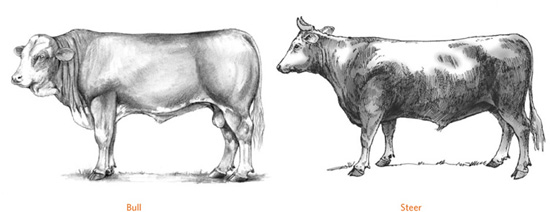
Raising a milk cow, or a calf or two for beef, is an efficient way to produce food, since cattle can mow the hillside behind your house that is too steep for a garden or survive on a back forty that has too much brush, rocks, or swamp to grow any crop other than grass. Cattle provide us with meat or milk while keeping weeds trimmed, which is a good measure for fire control and yields a neater landscape. Getting set up to raise cattle often does not involve much expense, except for the initial fencing to keep them where you want them. And if you don’t want to bother with purchasing hay and grain, you can use weaned calves to harvest your grass during the growing season, then send them for butchering when the grass is gone—thus making seasonal use of pasture and creating a harvest of meat.
Raising cattle can be a soul-satisfying experience. They are fascinating and entertaining animals; working with cattle is never boring. It can be physically challenging at times, as when delivering a calf in a difficult birth or trying to catch an elusive animal. But for those of us who enjoy raising cattle, the chores of caring for them are not really work. Our interaction with these animals is part of our enjoyment of life.
When you raise cattle, you participate in one of the oldest known human activities. Humans have lived with cattle since prehistoric times. Wild cattle were the main meat in the diet of Stone Age people. Our prehistoric ancestors began to domesticate cattle about 10,000 years ago to have a supply of meat for food and hides for leather clothing. Later humans discovered they could hitch these animals to a cart or a plow. In fact, oxen were used for transportation before horses were; cattle were domesticated sooner than horses, probably because they were easier to catch.
Getting Started ........................................................................ 272
Choosing a Dairy Breed ...................................................... 274
Choosing a Beef Calf ............................................................. 279
Understanding Cattle Behavior .................................... 283
Housing & Facilities ............................................................. 284
Feeding & Watering .............................................................. 289
Feeding an Unweaned Calf ............................................... 292
Weaning Your Calf ................................................................. 296
Butchering Beef Cattle ....................................................... 298
Care of the Milking Cow .................................................... 299
Milking a Cow .......................................................................... 300
Rebreeding Your Cow .......................................................... 302
Get Ready for Calving .......................................................... 305
When the Calf Is Born ......................................................... 306
Calf Management Procedures ......................................... 313
Keeping Your Cattle Healthy ........................................... 314
You can raise a steer in your backyard in a corral or on a small acreage, or you can raise a herd of cattle on a large pasture, on crop stubble after harvest, or on steep, rocky hillsides. Cattle can be fed hay and grain or can forage for themselves. Economics and individual circumstances will dictate your methods. If you have pasture, all you’ll need is proper fencing to keep the animals in, so they won’t visit the neighbors.
You will need a reliable source of water and a pen to corral the animals when they need to be handled for vaccinations or other management procedures. If you have a milk cow, you may want a little run-in shed or at least a roof, so you can milk her out of the weather if it’s raining or snowing. Most of the time, cattle don’t need shelter; their heavy hair coat insulates them against wind, rain, and cold. In hot climates, however, shade in summer is important. A simple roof with one or two walls can provide shade in the hottest months and protection from wind and storm in winter.
As a novice cattle raiser you may need advice from time to time from a veterinarian, cattle breeder or dairyman, or your county Extension service agent. Don’t be afraid to contact an experienced person to ask questions or request help.
Your choice in a calf will depend on how much space you have and whether you want to raise a steer to butcher or a heifer that will grow up to be a cow. A calf can be raised in a small area, even in your backyard if your town’s ordinances permit livestock. But if your goal is to have a milk cow that someday will have a calf of her own, she’ll need more room.
If you are raising a calf to butcher, you should probably raise a steer. Steers weigh more than heifers of the same age. However, heifers are more flexible—you can raise them as beef or keep them as breeding or dairy animals. Mature dairy heifers are worth more money than beef cattle. If you want to eventually raise a small herd of cattle, choose a heifer to start with. Her calves will become your herd.
Meet the Cattle Family
Cattle are of the order Artiodactyla, consisting of hoofed animals with an even number of toes. Most large land mammals are Artiodactyls, including goats, sheep, and pigs. Cattle are in the family Bovidae, consisting of animals with hollow horns. This family includes antelopes, goats, and sheep. The genus is Bos, the true cattle, of which there are two species:
B. taurus: descendants of British and European breeds, as are most cattle in North America
B. indicus: cattle with large ears and humped backs, which are especially adapted to hot climates, such as the Brahman
Bull. When a male calf is born, he is considered a bull because he still has male reproductive organs. Most bulls are castrated and become steers. Bulls can be unpredictable and dangerous.
Steer. A bull becomes a steer when he is castrated. The steer may still have a small scrotum or his scrotum may be entirely gone, depending on the castration method used. Beef calves are sold as steers.
Heifer. A heifer is a young female animal. Between her hind legs, she has an udder with four teats on it that will grow as she matures. A bull or steer calf also has small teats, just as a boy has nipples, but they don’t become large.
Cow. Once a female animal becomes older than 2 years of age and has had a calf, she is called a cow. A fresh cow is one that has recently given birth to a calf; a cow freshens once a year.
Your choice in a calf will depend on how much space you have and whether you want to raise a steer to butcher or a heifer that will grow up to be a cow.
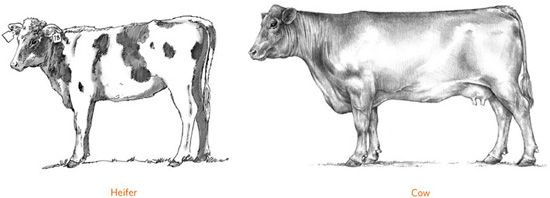
Miniature Might
Intimidated by the size of a standard cow? Consider a miniature one. Miniature livestock require less housing space, pasture, fencing, and feed than do their full-size counterparts. You can stock two or three miniature Herefords or Lowline Angus to one garden-variety cow. The three kinds of miniature livestock are naturally diminutive breeds that evolved as small animals to better survive the conditions nature handed them (like Dexters); small breeds that retained their original breed character when their parent breeds were selected for greater size (such as Miniature Jerseys and Lowline Angus); and breeds that were deliberately miniaturized by breeders who selected for smaller stature, often through outcrossing to an established smaller breed (like Miniature Highlands and Miniature Longhorns). One warning about selecting miniatures: Be sure you read up on dwarfism before you buy; dwarfs are not miniatures and should mostly be avoided.
You can be successful with any of the dairy breeds, but you may want to choose one that is popular in your area. The cost will be lower than for a breed that’s less numerous, and when time comes to breed your cow, you’ll have an easier time finding a bull of the same breed, if you so choose.
Ayrshire. Originating in Scotland, the Ayrshire is a medium-size red and white cow that may be any shade of red and sometimes dark brown. The spots are usually jagged at the edges. Ayrshires are noted for good udders, long lives, and hardiness. They manage well without pampering and can adapt to rocky land and harsh winters. They give rich, white milk.
Brown Swiss. Coming from the Swiss Alps, the Brown Swiss may be light or dark brown or gray. These cows are noted for their long lives, sturdy ruggedness, and ability to adapt to harsh climates. They give milk with high butterfat and protein content—ideal for cheesemaking.
Guernsey. Originating in the British Isle of Guernsey, Guernsey cattle are fawn and white with yellow skin. The cows are small as cows go, have good dispositions, and have few problems with calving. Their milk is yellow in color and rich in butterfat. Heifers mature early and breed quickly.
Holstein. Coming from northern Germany, Holsteins are large black and white or red and white cattle. A Holstein calf weighs about 90 pounds (41 kg) at birth compared to smaller breeds with calves typically weighing 60 to 70 pounds (27 to 32 kg). The cows are bred to turn grass into large volumes of milk that is low in butterfat. Holsteins are the most numerous dairy breed in the United States.
Jersey. Developed on the British island of Jersey, the Jersey is a small breed that may be fawn colored or cream, mouse gray, brown, or black with or without white markings. The tail, muzzle, and tongue are usually black. Jerseys mature quickly, calve easily, and are noted for their fertility. Jerseys produce more milk per pound of body weight than any other breed, and their milk is the richest in butterfat.
Milking Shorthorn. Originating in Britain, Milking Shorthorns may be red, red and white, white, or roan (a mix of red and white hair). These large cows are hardy and noted for long lives and easy calving. Their milk is richer than that of Holsteins but not as high in butterfat as that of Jerseys or Guernseys.
Buying a mature lactating dairy cow is the easiest way to start with a family milk cow, compared to buying a dairy heifer you must raise for two years, breed, and train before you get your first drop of milk. A mature cow should already be accustomed to being milked, be gentle, and be easy to handle and milk. Check with the person selling her to make sure she’s had the proper vaccinations and they are up to date, and she has been tested for brucellosis and tuberculosis, or any other requirements in your state. When in doubt about the required tests or vaccinations, ask your local veterinarian.
Also find out if the cow has been bred back again for her next calf. Unless she calved within the past few weeks, she should be bred again. You can have her checked by a veterinarian to tell if she is pregnant. If she has been milking for several months and is not pregnant, either the farmer didn’t rebreed her, or the cow has a fertility problem.
A dairy cow should always be rebred about two to three months after she calves, so she will calve again the next year. A cow may go several years without having a calf and still be milked, but her milk production will decline after the first six months and will gradually keep dropping. She will produce more milk for your family if she has a calf every year and is given a chance to go dry (not be milked) for at least 45 days, or better yet 60, before her next calving.
If the cow has recently calved and is not yet rebred, give her two to three months to recover from calving before rebreeding for her next calf. Some cows will come into heat less than a month after calving if they are well fed, but it’s too soon to rebreed them. Just keep track of her heat cycles when she comes back into heat, so she can be bred at the proper time. (For information on detecting heat, see page 302.)
Milk Factory
A top-producing dairy cow gives enough milk in one day to supply an average family for a month. The average milk cow produces 6 gallons a day (23 L), which is 96 glasses of milk. A world-record dairy cow can produce 60,000 pounds (27,216 kg) of milk per year—that’s 120,000 glasses of milk.
Quick Guide to Dairy Cow Breeds
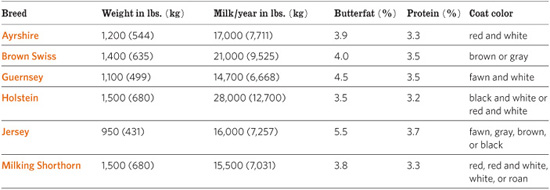
When your cow produces her annual calf, you might sell the calf to help pay for the cow’s maintenance, or you might raise the calf for beef. If the calf is a heifer, you might raise it as a second milk cow or as a replacement for your older cow if she is getting on in age.
A cow’s disposition is created partly by heredity. She inherits from her parents a tendency toward being nervous or placid, flighty or calm, smart or stupid, kind or mean. Just like humans, some cattle are smarter than others, and some are more emotional. But disposition is also influenced by how a cow is handled or trained. With patient handling, a timid, nervous heifer that is smart will often grow up to be a gentle cow. On the other hand, some wild and nervous animals can be frustrating, and dangerous, because they never learn to trust you.
The cow’s attitude will give you clues. She should be mellow and calm rather than nervous and flighty. A milking cow should be accustomed to having people near her and touching her udder. If she is nervous, doesn’t want to stand still, or seems inclined to move away or kick when you touch her udder, she will not make a satisfactory family milk cow.
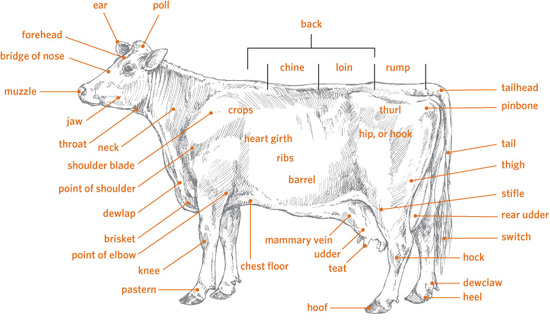
The word purebred refers to an animal whose ancestors are all of a single breed. A registered purebred has a registration number, recorded in the herd book of its breed association. The association gives the owner a certificate stating that the animal is the offspring of certain registered parents. However, not all purebreds are registered.
If you are thinking of selling your cow’s offspring, you’ll have to decide whether to buy a registered purebred or a grade cow. You are better off buying a good grade cow than a poor registered one. Registration papers won’t guarantee high production or good conformation, and grade cattle can take advantage of the benefits of cross-breeding. So don’t select an animal just because it’s registered.
If you opt for a purebred cow, join the breed association, which can give you educational materials and information and help you market your cow’s offspring. Transfer the registration of your new cow to your name. Be sure the color markings or the ear tattoo on the registration certificate is correct. For the Ayrshire, Guernsey, and Holstein breeds, you may use photos of both sides of your cow or sketches of the markings. For the solid-color breeds such as Jersey and Brown Swiss, an ear tattoo is required.
Performance records and the cow’s pedigree are two other documents you will want if you plan to register and sell your registered cow’s daughters. A pedigree is a record of all the cow’s ancestry. Most successful breeders keep additional detailed records that can be used to compare such factors as birth weight, weaning and yearling weights, milk production, and fertility. If you are not familiar with pedigrees and performance information, have the seller explain the records so you can understand how to use them.
A dairy cow is judged as much by the way she is built as by any other factors. Conformation is as important as performance records. A good milking cow should have outstanding breed character, which means that she closely resembles her ideal breed type. She should have style—all of her parts come together to create a good-looking animal.
Your cow should have good feet and legs. You don’t want a cow that will eventually become crippled because of poorly formed feet and legs. Her hind legs should be straight, not too close together at the hocks or splayfooted, and set squarely under her body. Her front legs should be straight. She should walk freely and smoothly without throwing her feet out to the side or swinging them inward.
The cow must have a feminine head and neck and a long body. A long body gives a cow more room for carrying a calf. She should have a deep, wide rib cage; a long, graceful neck; sharp withers; and a straight back (not humped or swayed) with wide, strong loins. Her rump should be level and square, not tipped up at the rear or slanted downward. If her rump is tipped up and her tailhead is too high, she will have trouble calving. The cow should be well balanced and well proportioned in all of her body parts, not short bodied, shallow bodied, or too short legged.
To give lots of milk, she must have a well-constructed udder. The teats should be evenly spaced, and all the same length and diameter. They should be well shaped and of a size to fit comfortably in your hand—not too long or too fat. Long teats and fat teats are difficult to milk, as are extremely short teats.
The udder should be well balanced, with all four quarters similar in size and shape, well spaced, and level—the front quarters not higher or lower than the rear quarters. The bottom of the udder, between the teats, should be flat rather than bulging. The udder should have strong attachments, meaning the muscles and ligaments holding it up against the cow’s abdomen keep the udder relatively high and tight, rather than hanging low and pendulous. Otherwise the udder may break down as the cow ages, swinging back and forth and hitting her legs as the cow walks or trots, making the udder susceptible to bruising and mastitis. Looking from behind, the udder should appear well attached between the thighs, rather than sagging.
You may be able to buy a cow from a neighbor or a local dairy. You can also check the ads in your local or regional farm newspapers or ask at the farm store—or see if the local veterinarian or county Extension agent knows of anyone with a milk cow for sale. If you pass the word along that you are looking for a family cow, you will eventually find one. It’s always better to buy directly from the previous owner than from an auction. A cow going through an auction is usually being culled for one reason or another. She may be old or crippled, infertile, or have some other problem. Good cows may go through an auction, but you can’t always tell by looking. For instance, a nice young cow may have a uterine infection, making her infertile.
How Long Does a Cow Live?
In an industrialized dairy—where the cows are crowded, pushed for milk production, and stressed out—the average life span is only 4 or 5 years. By the age of 6 a cow is considered old, and few cows are milked beyond the age of 7. A well cared for family cow, on the other hand, may produce milk to 15 years or older, and may survive to the ripe old age of 20 or even 25. The oldest cow on record was an Irish milker named Big Bertha; she died in 1993 just three months short of turning 49.
If you buy from the previous owner, you have more chance to examine the cow closely and ask questions. You can learn more about her history and make sure she’s had all her vaccinations. A dairy might sell you a young, healthy cow that is just not producing enough milk to pay her way. She would be fine, however, for a family milk cow that doesn’t need to be a top producer.
Another place to buy a cow is from a dispersion sale or farm sale, when a dairy is selling out or a farmer is retiring. In such a case you may be able to buy a cow that has just calved, with her new calf at her side.
Beef breeds are stockier and more muscled than dairy breeds. The latter have been selected for their milking ability rather than for beef production, and the cows are finer boned, are more feminine, and have larger udders so they can give much more milk. The many beef breeds have differences in size (height and body weight), muscle traits (lean or fat), color and markings, hair coat and weather tolerance, and so on.
Your best consideration in selecting from among the many breeds is to determine which ones are available locally—since they are more likely to be adapted to your climate, as well as being easier to locate and transport to your place.
You may also want to consider finish size. A small-framed animal takes less feed and usually matures and reaches finish weight more quickly than a large one. If you have a small place or don’t want a huge amount of meat, a small-framed animal like a Dexter or even a crossbred dairy-beef calf from one of the smaller dairy breeds might be just right. If you have a larger acreage and a big family and you want lots of beef, you may prefer to select a calf from one of the larger-framed breeds. A crossbred beef calf is often the best selection, since it will have the advantage of hybrid vigor for better feed efficiency and faster weight gain. Crossbred animals also tend to be hardier and healthier.
Most cattle breeds are horned and some are polled (naturally have no horns). Angus cattle are polled, and some of the horned breeds are infused with Angus genetics so they have black and polled offspring—two traits popular with many stockmen. Now the traditionally red and horned European breeds like Limousin and Simmental have black, polled versions. Angus and Angus-cross cattle have an additional advantage of finishing faster and being ready for butchering in little more than a year, compared to larger-framed breeds that may take two or more years to finish, although the Angus-type cattle will produce less beef.
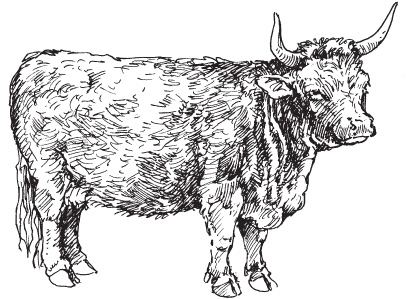
Dexters are the smallest cattle breed and are used for both milk and beef. The average cow weighs less than 750 pounds (340 kg) and bulls weigh less than 1,000 lbs. (454 kg). Dexter cattle are quiet and easy to handle, and the cows give rich milk.
Beef Breeds
Beef breeds in North America are descendants of cattle imported from the British Isles, European countries, Australia, or India. Many modern breeds are mixes of these imported breeds.
British breeds originated in England, Scotland, and Ireland. They include Angus, Dexter, Galloway, Hereford, Scotch Highland, and Shorthorn.
Continental, or European, breeds are generally larger, leaner, and slower to mature than the British breeds and are popular for crossbreeding with British breeds to add size and muscle (and sometimes milk). These breeds include Braunvich, Charolais, Chianina, Gelbvieh, Limousin, Maine Anjou, Normandy, Pinzgauer, Piedmontese, Romagnola, Salers, Simmental, and Tarentaise.
Some beef cattle breeds originated in places other than the British Isles and Europe. They include the Brahman from India, the Murray Grey from Australia, and the Texas Longhorn, an American breed descended from wild cattle left by early Spanish settlers in the Southwest.
The breed you choose for raising a beef animal for your freezer is not as important as the disposition of the individual you select. Some calves are more placid and easygoing than others. If you are getting only one calf, try to select a mellow one, not a skittish one that will get nervous being by himself. Try to choose a smart and gentle one that will readily learn to trust people.
Don’t choose a wild calf. A wild, snorty calf is a poor risk, even if he is big and beautiful. You may have trouble gentling him, and he may try to go through fences. He could also be dangerous—he might knock you down or kick you. A wild calf won’t gain weight as well as a placid calf. Rate of gain (pounds gained per day) is almost always better with a gentle calf.
An auction is the riskiest place to buy a young calf. Even though the calf may have been healthy when taken to the auction, it may get sick after you take it home. Some calves become sick because they are taken from their mother and sold before they have had a chance to nurse enough colostrum, which is loaded with antibodies that protect the calf against disease until it can develop its own immune system.
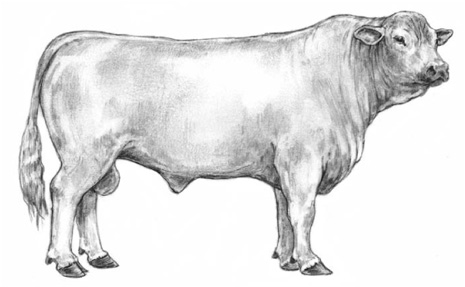
The Murray Grey is a silver-gray breed from Australia that is gaining popularity in North America because of its moderate size, gentle disposition, and fast-growing calves. The calves are small at birth but often grow to 700 pounds (318 kg) by weaning.
A sale yard is also a good place to pick up diseases. Cattle come and go, and they spend time in pens before being sold. Some of the cattle brought to a sale may be sick or coming down with an illness. Even if most of the cattle that go through the pens are healthy, germs may contaminate those pens. Don’t buy a calf at an auction if you have other options.
A good place to buy a beef calf is at a feeder calf sale in the fall or at a farm or ranch. A local purebred breeder or commercial cattle producer is always the best source. Buying direct from a local farmer or rancher gives you an opportunity to look at calves, ask questions, and determine the personality and tractability of each animal.
Most dairy farms have many newborn calves to sell in the spring. Dairy cows must have a calf every year to produce their maximum amount of milk. A cow makes much more milk after she freshens. Her volume of milk is greater a month or two after calving. From then on, her production gradually declines. Dairy cows are kept at maximum production by being bred every year to have new calves and then being allowed to dry up briefly before the new calves arrive.
Some dairies sell all their calves. Others keep their heifers and raise them to sell to other dairies. Bull calves are usually sold as soon as they are born and are cheap because most dairy people don’t want to take the time to raise them.
Watch for Signs of Sickness
Before you take home your new cow or calf, make sure it is healthy. The animal should look bright and perky, be lively and energetic, and have a glossy hair coat and a sparkle to the eyes. Bowel movements should be firm but soft, not hard or excessively runny.
If an animal is dull or slow moving, has a dull or rough hair coat, has foul-smelling manure, or has droopy ears, it is sick. Also beware of an animal that stands with its back humped up or has a cough or a runny, snotty nose. If you are in doubt about the health of an animal, have a veterinarian or other person with cattle experience look at it.
After you bring home a calf, pay close attention to detect early signs of illness. Calves easily get pneumonia, and a calf with pneumonia may die. If your calf looks like it doesn’t feel well, don’t wait to see whether it gets better or worse. Get advice immediately from a person experienced at raising cattle, or call a veterinarian.
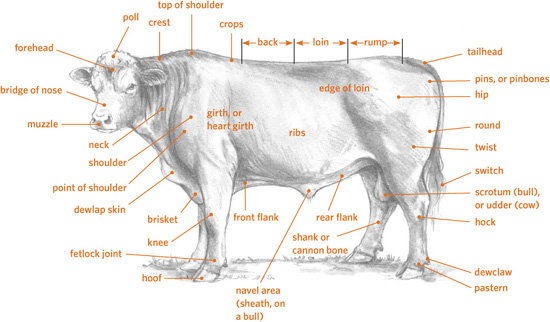
Some of the calves at a dairy can be crossbred (half beef), if the dairyman breeds his heifers to a beef bull that sires small calves for easy calving. Crossbred calves of either sex can often be purchased cheaply. They make good bucket calves to raise for beef.
The best steer to raise for butcher is a fast-growing, well-muscled animal that will reach a market weight of 1,050 to 1,250 pounds (476 to 567 kg) by the time he is 14 to 20 months of age. Beef cattle are categorized by frame score, which tells you whether they are small, medium, or large bodied. A small-frame, early-maturing steer will not produce as much meat on his small carcass as a larger-frame animal. If you try to get him to grow bigger, he’ll just get too fat; he is not genetically capable of attaining a larger size. A large-frame steer will grow too big before he gets fat enough to butcher and will use up more feed than is necessary. The most practical kind of beef steer has a medium frame.
The animal you pick should have a lot of muscle, not a lot of fat. If the calf is already fat, he may not grow well. On the other hand, the animal should not be too thin, either. Thinness may indicate that the animal has been sick or is currently not healthy. He should have nice, smooth lines and should not be swaybacked. He should have a deep body, neither shallow nor potbellied. He should be long and tall, but not overly tall.
A Steer Is No Bull
If you buy a weaned calf, make sure it has been castrated. You want a steer, not a young bull. Although a dairy calf or a dairy-beef cross is usually cheaper than a beef calf, it most likely will not be weaned. You’ll have the task of feeding the calf milk replacer by bottle or bucket for a few months until it becomes large enough to thrive on pasture alone. Such a calf will likely still be a bull, so you’ll need to castrate it (for details, see page 313). Never try to raise a young bull. Even though he may be friendly and mellow as a baby, he will become more aggressive and unpredictable (and dangerous) as he gets older.
Make arrangements with someone who has a trailer or a pickup truck with a rack to haul your animal home. If you are buying the animal from a farmer, rancher, or dairyman, he may be able to haul it for you; ask what he would charge.
If you will be unloading into a pen or a pasture, a trailer often works best, because it is low to the ground and the calf or cow can step out of it easily. An animal transported on a truck must be unloaded at a loading chute. Even a pickup truck with a rack is often too high for an animal to jump out of without risk of injury, unless the truck can be backed up to a bank or you have a ramp.
Remember that most beef calves have lived with their mothers in large pastures. Some may have seen people close up only during vaccinations or medical treatment, which are scary and painful experiences. Therefore, your calf may be frightened by you, and it may even try to run over you if you get in its way as it comes out of the truck or trailer.
When you get home, make sure the trailer is backed far enough into the pen that the animal has no choice but to enter the pen. The gate of the pen should be swung tight against the trailer. A scared animal may try to bolt through even a small opening. Don’t stand in a place where the animal might run over you. If you are unloading from a pickup truck, make a ramp of sturdy boards.
Figuring Frame Score for Beef Calves
To figure a calf’s frame score, measure his height from the ground at the hip when he is standing squarely. Then look up his age on this chart and find the hip height on that age line. Look to the top of the column for the frame score. For instance, a 10-month-old calf that is 45 inches (114 cm) tall at the hips would have a frame score of 4. Calves with frame scores of 1 or 2 are small, 3 to 5 medium, and 6 and 7 large.
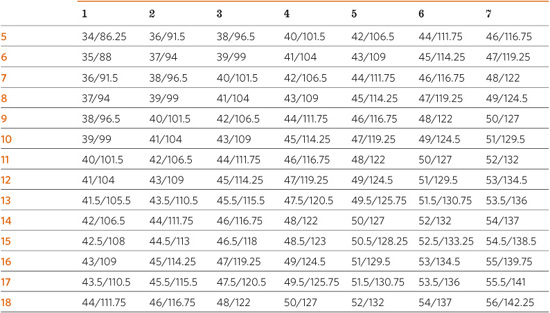
Wild cattle were safer in herds. If wolves approached, the cows would bellow and form a tight group. That’s why yearlings and young cattle generally travel in a group. If one goes to water, they all do; if the leader decides it’s time to graze, they all go. They are not just copycats; they hang together for protection.
Your new calf or cow is probably lonely and scared, unless it has another animal for a buddy. Try not to frighten the animal; it may become upset and crash into the fence. To understand your new animal, try to think like it does. Cattle are herd animals and are happiest when they are in a family group with other cattle.
If your calf was weaned before you bought it, it has already gone through the emotional panic of losing its mother. It will miss the other calves it was with, but it won’t be quite so desperate to get out of your pen to find its mother. But if the calf is still going through weaning when you bring it home, it will have several days of stressful adjustment. It may pace the fence and bawl, and it may show little interest in feed or water. A calf being weaned is more susceptible to illness because stress hinders the immune system. In cold, rainy, or windy weather, a weaning calf may be particularly likely to get pneumonia.
As you begin to get acquainted with your new animal, give it time and space. Don’t try to get too close. Until it gets to know you, it may react explosively if it feels cornered.
Speak softly and move slowly around the animal. As you approach the pen with feed, let it know you are there. If its attention is diverted and then it suddenly sees you, it may run off. Talking softly or humming a little tune can help gentle a frightened animal.
Making Friends
Cattle like to be petted and scratched, especially in places that are hard for them to reach. Most love to be scratched under the chin, behind the ears, and at the base of the tail. But don’t rub the top of the head or the front of the face. Rubbing these spots will encourage a cow or a calf to bunt at you.
When you are in the pen with your animal, don’t look directly at it. It will relax more if you act as if you aren’t paying attention to it. If you come too close, approach too quickly, and look directly at it, it will see you as a predator. Instead, ignore the animal, but talk softly as you go by. Pretty soon it will come eagerly to meet you when you bring feed.
Your calf or cow has probably not spent much time with people, so don’t just turn it out and ignore it. Spend some time walking around in the pasture and let it get used to you. Cattle will let you get closer once they know you are nothing to fear.
Some cattle are not timid and will be curious about you from the beginning. Use this curiosity to your advantage. If you are patient and quiet, the cattle will come closer to you.
The flight zone. Cattle have a certain personal space in which they feel secure. As long as you don’t enter that zone, they feel safe. But if you get too close, they’ll get nervous or scared and run off.
Different cattle have different-size zones. A wild or timid calf has a large zone; a gentle or curious animal has a much smaller one. As your cattle get to know you well, the flight zone will disappear.
Use feeding to your advantage. When cows and calves begin to associate you with food, most will lose their fear and come right up to you. They may need a few more days before they will let you touch them, but they will soon stand beside you and eat.
Cattle are good at making associations between things. If you have a special call for feeding time, they’ll come to you every time they hear it.
Don’t spoil your animal. Don’t make the mistake of spoiling a cow or calf. It should trust you, but it must also respect you. Remember that cattle are social animals and accustomed to life in a group, in which they boss other cattle around or get bossed. Cattle will think of you as one of the herd. You must be the dominant herd member; they must accept you as the boss cow. Otherwise, they will try to be too pushy.
If a calf or cow starts pushing you or bunting at you when you are feeding or petting it, discipline it with a swat. Pushing and bunting is the cattle version of play. A calf or cow will naturally want to play fight with you, as cattle do with one another.
If you spoil your animal by letting it do whatever it pleases, you will regret it later. Carry a small stick when you go to feed your animal; if it gets sassy, rap it on the nose. This swat will remind it that you are the boss.
Be careful. Although calves and cows are not likely to attack a person (unless a cow is defending a new calf), they can accidentally hurt you because of their size and weight. Always keep an escape route in mind when trying to corner or work with a cow or a calf. Leave enough room to dodge aside if one backs into you or turns around and runs back out of a corner.
Cattle can be dangerous when handled in a confined area, because they tend to panic. Don’t wave your arms, scream, or use a whip. If an animal won’t move forward into the catch area, prod it with a blunt stick or twist its tail. Just be careful to not twist the tail too hard. You can twist it into a loop or push it up to form a sideways S curve. If you have to twist the animal’s tail to get it to move, stand to one side so it can’t kick you.
Be gentle. If you yell or chase your cattle, you may scare them badly. Even if they are stubborn or suspicious and won’t go into the catch pen or behind the gate or panel on the first try, don’t get impatient. If you lose your temper and yell, you’ll confuse or scare them and make things worse. They’ll be harder to handle next time.
Before you buy a calf or cow, prepare the place where you’ll keep it. A young calf needs shelter from sun, wind, and rain. A mature animal is hardier but still needs protection from driving wind and hot sun. In most climates a three-sided shelter offers sufficient protection from the elements, but if you’ll be milking your cow on cold winter days you’ll appreciate a more secure structure.
If the animal will be living by itself, build a strong pen to put it into for a few days before you turn it out to pasture. Be sure the fence is constructed so the animal cannot jump over or crawl through it. A frantic, homesick animal in a new place may try to escape. If the calf you purchase has already been weaned, it won’t be so desperate to get back to its mother.
Make sure your pen or pasture has no hazards, such as nails or loose wires that might injure the animal. Calves are curious, just like little kids, and they often get into trouble. A pole or board on the ground with nails sticking out of it can cause serious injury if stepped on. Nails or bits of wire lying around near the feeder may puncture the animal’s stomach if it eats them, causing hardware disease, which is often fatal. Don’t leave baling twine hanging on a fence or lying on the ground, and watch for stray garbage: If a calf or cow tries to eat baling twine or chews on a plastic bag that has blown out of your trash, pieces of the material may plug its digestive tract and kill it. Any electrical wires in the barn must be out of your animal’s reach, as well.
The pen must be dry and have good drainage. If necessary, put sand in the bedding area or a shady spot where the animal sleeps to make sure the area stays dry.
Build pens and erect fencing on solid ground. Posts set in a boggy, wet area will become loose and wobbly. The postholes can be dug with a shovel if the ground is mainly dirt with just a few rocks. If the ground is really rocky, you’ll need an iron bar to loosen the rocks as you dig.
Use metal or pressure-treated wood posts to prevent rot. Set the posts in a straight line. A crooked fence is not as strong as a straight one. Set the corner posts and sight between them to line up your postholes and your posts, or stretch a long string between them to give you an exact line. Set holes around the posts with dirt and rocks. To set the posts solidly, put in a little material at a time and tamp the dirt firmly with an iron bar or a tamping stick before adding more. (For more information on putting up fencing, consult a good reference book such as Fences for Pasture and Garden by Gail Damerow.)
Wire fence. A good wire fence will hold cattle that are not being crowded or trying hard to get out. The wire must be tight, without slack, so the cattle won’t get into the habit of reaching through it. If they can reach through it to eat grass, they may eventually push through it. Net wire is the best option, because cattle cannot get a nose through it.
All calves need shelter, but a brand-new calf is especially fragile and needs to be kept warm and dry. If you live in a cold-weather region, you’ll need to keep a young calf in a warm barn stall or in your garage or back porch until it is several days old and can live outdoors.
A calf pen can be built with sturdy wood posts. The posts should be at least 8 feet (2.5 m) long, enough to set deeply into the ground but make a fence at least 5 feet high (1.5 m), and should be set 8 to 10 feet (2.5 to 3 m) apart. Use poles, boards, wood or metal panels, or strong woven-wire netting as fencing between the posts. Barbed wire or smooth wire won’t work, because a calf can get through it if it tries hard enough. Do not use an electric fence to create the pen. You may need to corner the calf in the pen—or it may corner you—and you don’t want it or you to get shocked. Don’t skimp on materials; a good pen may be expensive to build but will last a long time.
If the calf will spend all of its time in the pen, it should be large enough to give the calf room for exercise, at least 900 to 1,000 square feet (275 to 300 sq m). You can configure the pen however you like, such as 10 by 100 feet (3 by 30 m), 20 by 50 feet (6 by 15 m), or 30 by 30 feet (9 by 9 m)—whatever fits the space you have. If you are raising more than one calf, add at least 200 square feet (60 sq m) of space to the total area for every additional calf. The pen should offer shade from a building or a tree. A calf needs about 100 square feet (30 sq m) of shade in summer.
You’ll need a small catch pen in one corner of your pen and a place where you can restrain the calf for giving shots and medications. A small, enclosed shed or feeding area can be used for cornering and catching the calf. If you make a gated chute at one corner of the pen, you can herd your calf along the fence and into the chute and swing the gate shut behind it. You might include a head catcher or stanchion in the calf’s feeding area, which allows you to lock its head in place when it sticks it through to eat. The stanchion will restrain the calf sufficiently for veterinary care.

Typical layout for a calf pen and shed
Wire fence with braces and metal stays

Net wire fence with one barbed wire on top
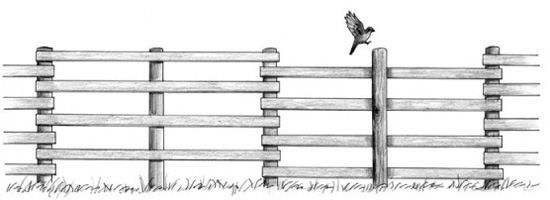
Corral fence with posts and poles
Whenever you inspect your fence, replace any missing staples on wood posts or clips on metal posts so the wire is attached properly. Tighten any sagging wires. Make sure the fence has no holes through which a calf might be able to get out. If the fence stretches over a dry ditch, a calf or yearling may be able to walk right under the fence. Put a pole across the ditch, under the fence, and secure it so that a calf can’t push it away.
Electric fence. An electric fence will prevent animals from getting through or rubbing against a wire fence. After being shocked a few times, the animals won’t touch the fence.
For an electric fence, you’ll need a battery-powered or electric fence charger and insulators to attach the wire to the fence posts. Do not allow the electric wire to touch anything metal; it will short out and won’t work. It also shouldn’t touch wood posts or poles, because it will short out whenever the wood gets wet. Keep all weeds and brush around the electric fence clipped to keep the fence working and to avoid a fire.
A portable or temporary electric fence can be used to divide a large pasture into several smaller ones for pasture rotation. Even if you have only a small acreage, the grass will last longer if you practice rotational grazing
Check That Fence
If you’re raising animals on pasture, you’ll need to check the fences frequently and carefully to ensure they are in good shape. And be sure to give fences a good once-over before you bring home a new animal. A calf or cow that has never lived alone may be frantic when you first bring it home. It may try to get out of the pasture to rejoin the herd it lived with.
In a mild climate, cattle may need only a small three-sided shed, or a protected fence corner with a roof and some boards or plywood on the sides for windbreak. You can make a simple shed by setting a roof on tall, sturdy posts. A freestanding shed with walls on three sides will better protect the animals from bad weather.
Before you build a shed, figure out which way the wind usually blows in that spot. Place the shed walls to offer the greatest protection from wind. Two sheets of exterior-grade plywood placed on each side of a fence corner make a nice windbreak; add another sheet of plywood to make a roof.
If you live in a hot climate, a shed roof will provide shade, but you’ll also need airflow to help keep the animals cool. The roof should be high rather than low, and the shelter should have no walls, which would halt air movement.
The shed should be built on a high, dry spot with good drainage. The roof should slope so rain or melting snow will run off. Make sure it slopes away from the main pen so the runoff doesn’t create mud in the pen or flow into the shed.
Add bedding for your animal to lie in. Straw, bark mulch, or wood chips scattered into a bed in the corner of the shed will give them a dry place to sleep. Make sure the bedding area is in a high, dry spot. The animal should always have dry bedding. Moist, dirty bedding contains harmful bacteria and also conducts warmth away from the animal’s body, causing it to become chilled and more susceptible to disease. Also, ammonia gases given off by bedding that is wet from urine and manure can irritate and weaken the animal’s lungs, especially a young calf’s, and allow bacteria to become established and lead to pneumonia.
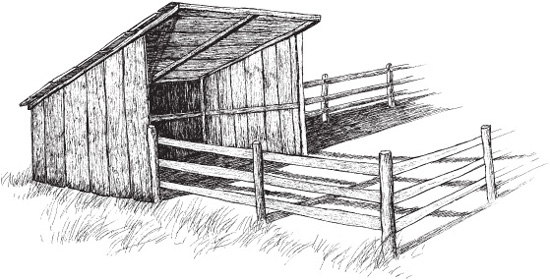
A simple shed with two or three walls can provide adequate shelter.
Make a Water Trough
You can make a water trough from anything that will hold water and can be cleaned easily, such as an old washtub or large bucket. You will also need to make a stand or frame to hold the tub. Nail a board across the corner of the pen or stall, leaving room for the tub or bucket to fit snugly between it and the walls. You can easily pull the tub or bucket up out of the corner to rinse and clean it, but cattle can’t tip it over.
In a large pasture, manure serves as fertilizer. But in a pen or shed, it needs to be cleaned out. If an animal spends much time in its shed, manure and soiled bedding must be cleaned out regularly so it doesn’t build up.
A corral may be easiest to clean with a tractor and blade or loader, whereas to clean a shed or bedding area, a wheel-barrow and manure fork will suffice. A manure fork resembles a pitchfork but has more tines, so manure and straw can’t fall through it easily.
Manure makes excellent fertilizer. Spread the manure over your pasture or garden, or make a compost pile from manure and old bedding.
You will need a good halter and rope for restraining your calf or cow so that you can tie the animal to the fence or to the side of the chute if necessary. An inexpensive, adjustable rope halter with lead rope can be purchased at a feed store or through a mail-order catalog from a livestock supply company. When putting on a halter, place it on the animal so the adjustable side is at the left. When you pull it tight, the pressure should be mostly on the rope under the chin, rather than behind the ears.
At some point, you may need to tie up your calf or cow. For your safety and that of your animal, you’ll need to know how to make a good knot that will stay tied but can be untied easily, even if the animal has pulled hard on the rope.
Overhand knot. The simple overhand knot is the one you make first when tying your shoes. This basic knot is often the first step in forming more complex knots.
Bowline knot. The bowline knot is probably the most useful nonslip knot for working with livestock. It allows you to tie a rope around the animal’s neck or body without the danger that it might tighten when the rope is pulled, and it is relatively easy to untie. An easy technique for remembering how to tie a bowline knot is to think of the following story. The first loop is the rabbit hole, the standing part of the rope is the tree, and the working end of the rope is the rabbit. The rabbit comes out of the hole, runs around the tree, and goes back down its hole.
Double half hitch. The double half hitch knot is quick and easy to tie, acts like a slipknot, and is a handy way to secure the rope around an animal’s leg when you are tying a leg back or to secure the end of the rope when no other knot seems appropriate.
Square knot. The square knot is a stronger version of the overhand knot; it consists of two overhand knots, one tied on top of the other. The square knot is perfect for joining two pieces of rope, as when you are joining a broken rope or tying a rope around a gate and gatepost to keep the gate closed. A properly tied square knot will not slip from its position.
Quick-release knot. The quick-release knot (also called a reefer’s knot, a bowknot, or a manger tie) is useful for tying your calf to a fence post. Like the square knot, it is a good nonslip knot. The quick-release knot has the advantage of being easily untied even after it has been pulled tight, as will happen if your calf pulls back on the rope.
Common Knots
To tie the five most common knots, follow these simple step-by-step diagrams.
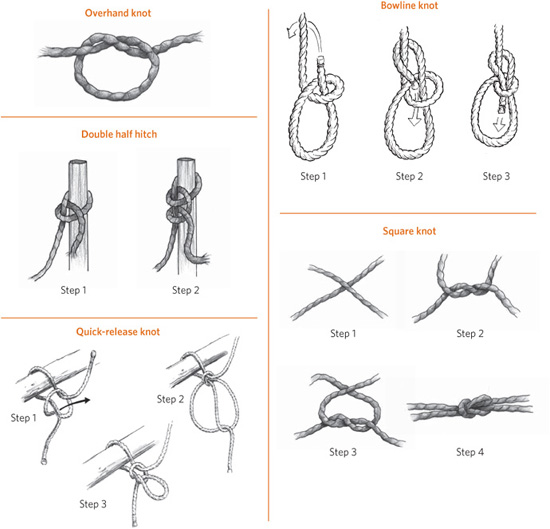
Cattle require a source of fresh water, which can consist of a tub or tank filled twice a day with a garden hose. A water tub for calves should be set up off the ground, but no higher than 20 inches (50 cm); anything higher will keep them from drinking easily. Calves may step or poop in a tub on the ground. Using a feed rack or manger will reduce hay wastage. Cattle won’t eat hay that has been stepped on or has manure on it.
You must make sure your cattle have water available at all times. Cattle drink more in hot weather than in cold weather, so check the trough more often in summer. In the winter, keep the water from freezing, even if it means breaking ice every morning and evening. In really cold climates, a rubber tub is a useful water tub, because you can tip it over and pound on it to get the ice out without creating a leak. If you use a hose to fill the trough, drain the hose thoroughly after each use in cold weather to keep it from freezing.
The water should be kept away from the feed rack or feeding area to keep cattle from dragging feed into the water. It should be located far from where the cattle bed. If the cattle have to walk some distance to the water, they will be less likely to stand close to it and defecate in it by accident. Keep the water fresh and clean, even if you have to dump and rinse the tub every day; cattle won’t drink dirty water. Use a tub or tank that is easy to dump or has a drain hole at the bottom, and rinse it before refilling. The more cattle you have, the larger the tank you will need, or the more often you’ll have to fill it.
Clean out any hay that collects in the bottom or corners of the feeder; wet hay may become moldy. Moldy feed may make your animal sick, and the mold spores that are released into the air when the animal eats may make it cough. To help prevent dampened hay, place the feed area inside a weather-resistant shed. If you feed your cattle outdoors, build a roof over the feed manger, hayrack, or grain box or tub.
If you are feeding hay in winter or when pasture gets short, scatter the hay on well-sodded ground. More hay will be wasted if cattle are fed on bare dirt or mud.
Some people like to fatten their beef cattle on grass, without any grain, though grass feeding takes longer to get a calf up to butchering weight. If you prefer grainfed beef, you’ll have to feed your calf grain every day after it is weaned.
You’ll need a sturdy trough or grain box, mounted off the ground so the calf won’t step in it and held securely so the calf can’t pull it down. Calves will not eat dirty grain. A rubber tub is easy to wash out and works well if you have only one calf. Build a roof over the tub or feed box to keep the grain dry.
Clean out any leftover kernels before adding new grain to the box. If birds have pooped in the tub or trough, or any old, fermented, or moldy grain remains in the corners, the calf may refuse to eat the next batch you put in.
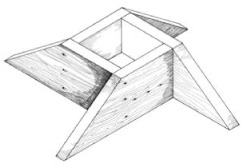
A salt box or grain box can be made of four 1 in. by 8 in. (2.5 × 20 cm) boards and a bottom.
Cattle are ruminants, meaning they have four stomach compartments and chew their cud. The four compartments of a ruminant’s stomach are the rumen, the reticulum, the omasum, and the abomasum or true stomach, which is similar to the human stomach.
When a ruminant eats, it chews food only enough to moisten it for swallowing. After being swallowed, the food goes into the rumen to be softened by digestive juices. After the animal has eaten its fill, it finds a quiet place to chew its cud. It burps up a mass of food along with some liquid, swallows the liquid part, and then chews the mass thoroughly before swallowing it and burping up some more. The rechewed food goes into the omasum, where the liquid is squeezed out, and then goes on into the abomasum. Ruminants developed this way of eating so that they could cram in a lot of feed while grazing in open meadows and then retreat to a safe, secluded place to chew more thoroughly.
Make a Feed Trough
You can make an inexpensive feed trough with 2-inch (5 cm) lumber cut into lengths. If several calves will be using the trough, allow 3 square feet (1 sq m) per calf. Make the sides of the trough at least 6 inches (15 cm) high. Set the trough no higher than 18 to 20 inches (46 to 50 cm) off the ground.
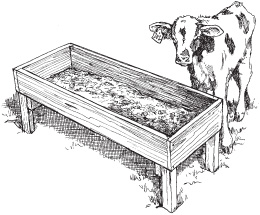
Cattle do well on a wide variety of feeds. To some extent, what you feed your animal depends on whether it is being raised for beef or milk. However, the basic elements of good nutrition are the same for all cattle. Make sure the feeds contain a balance of the basic ingredients for good nutrition: protein, carbohydrates, fats, vitamins, and minerals.
Protein. Protein is necessary for growth. Good sources of protein include high-quality legume hay, such as alfalfa or clover; pasture grasses; or high-quality grass hay. (With alfalfa, care must be taken to avoid bloat—see page 316.) Protein supplements include cottonseed meal, soybean meal, and linseed meal. Cattle that are feeding on good hay or pasture don’t need supplements.
Carbohydrates and fats. Carbohydrates and fats provide energy and are used for body maintenance and weight gain. Barley, wheat, corn, milo (grain sorghum), oats, and grain by-products, such as mill run and molasses, contain a high proportion of carbohydrates and a small amount of fat. Extra fat can be fed using a high-fat product designed for ruminants, such as Calf Manna.
Vitamins. Vitamins are necessary for health and growth. Green pasture, alfalfa hay, and good grass hay contain carotene, which the animal’s body converts into vitamin A. Overly mature, dry hay may be deficient in carotene. The other vitamins cattle need are either in the feed or created in the animal’s gut, except for vitamin D, which the animal’s body synthesizes from sunshine. Your cattle will get enough vitamin D unless they spend all their time indoors.
Minerals. Minerals occur naturally in roughages and grain. Cattle don’t normally need mineral supplements beyond those found in ordinary feeds. However, if the soil in which their feed was grown is deficient in iodine or selenium, they may require supplements of these minerals. In some regions and situations, they may also need copper supplementation, phosphorus, or some other mineral to prevent deficiency. Check with your local Extension agent or cattle nutritionist for advice on the mineral needs of cattle in your area and always inquire before adding supplements. Some supplements are harmful if overfed.
Cold-Weather Feeding
In cold weather, cattle need more feed to generate body heat and keep warm. Roughages provide more heat than do grains, because of the fermentation that takes place during digestion. If the weather is cold, increase the ration of grass hay.
Salt is important for proper body functions and for stimulating the appetite. It is the only mineral not found in grass or hay. Always provide salt for your cattle, either in a block or as loose salt in a salt box. Trace mineral salt can be used if feeds in your geographic region are deficient in certain minerals. Trace minerals include cobalt, copper, iodine, iron, manganese, selenium, and zinc. Your veterinarian or county Extension agent can help you figure out which kind of salt to use and whether it should include trace minerals.
If your cow or calf is grazing on lush spring pasture, you may need to feed extra magnesium to avoid grass tetany, which can be fatal. Check with your vet, Extension agent, or local feed store.
Grain enables a beef calf to reach market weight faster, and a cow needs grain to meet her nutritional needs while producing milk as well. Grains, also called concentrates, include corn, milo, oats, barley, and wheat. In the Pacific Northwest barley is plentiful and can be used instead of milo or corn.
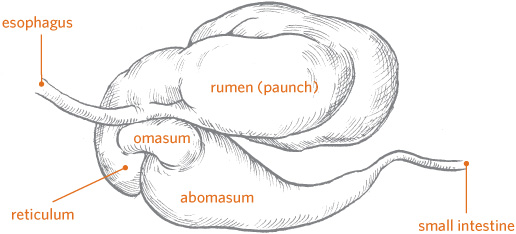
Cattle and other ruminants have four-part stomachs.
Cattle need about 3 pounds (1.5 kg) of hay daily for each 100 pounds (45 kg) of body weight. For example, a 500-pound (227 kg) calf needs about 15 pounds (7 kg) of good hay each day. If you wish, you can reduce the hay ration by replacing some of the hay with grain. Since grain is a more concentrated source of nutrients, substitute about a half pound (225 g) of grain per pound of hay. Overfeeding on grain can cause digestive problems or founder, so grain should never constitute more than half the ration by weight.
Wheat is usually too expensive to feed to cattle. Corn is high in energy and is commonly used for calf feed when it is available. Oats also make good feed, as does dried beet pulp with molasses.
Roughages, sometimes called forages, are feeds that are high in fiber but low in energy—such as hay or pasture—and are the most natural feeds for cattle. Although cattle do well on them, they don’t grow or fatten as fast as they do on grain. If you are raising a beef animal and don’t need it to grow quickly, or you are raising a weaned heifer to keep as a cow, feed mostly roughages and little or no grain.
If you don’t have pasture for your cattle, you’ll have to feed them hay, which is basically pasture plants that have been harvested and dried. The type of hay you feed will depend on what’s available in your area. Alfalfa, clover, and timothy are common, but any number of other grass and legume hays are suitable.
Alfalfa hay is richer in vitamin A, vitamin E, protein, and calcium than grass hay, but be careful not to overfeed your cattle on it. Alfalfa hay can cause digestive problems and bloat, meaning the rumen becomes too full of gas. The gas causes the rumen to expand like a balloon and puts pressure on the animal’s lungs and large internal blood vessels, causing it to die. Feeding a mix of grass hay and alfalfa hay is safer.
First-cutting alfalfa often has a little grass in it and can be an ideal hay. Second- or third-cutting alfalfa is generally richer and more likely to cause bloat. In addition, alfalfa hay becomes moldy more readily than grass hay if it gets wet or is baled when it is too green. When buying alfalfa, make sure it is green and bright, with lots of leaves and fine stems; it should not be coarse or brown and dry. Alfalfa that is cut early, before it blooms, is finer and more nutritious. Alfalfa that has bloomed has less protein and coarse fiber with larger stems.
Make sure any hay you buy is not moldy or dusty, because mold and dust may create digestive or respiratory problems. Hay for calves should not be stemmy or coarse. Because the protein and nutrition of hay are mainly in the leaves, stemmy hay is not nutritious, and it’s hard for a calf to chew. Adult cattle can handle coarser feed than calves can. If you have no experience in buying hay, ask your county Extension agent or another knowledgeable person to help you.
Pasture should contain several types of nutritious grasses. Cattle won’t do well in a weed patch. If you are a pasture novice, have your county Extension agent look at your pasture and offer advice on any needed renovation.
In the early spring, pen up your cattle and feed them hay for a while to let the pasture grow. Otherwise, your cattle will eat the new green grass as soon as it starts to grow, and it won’t become tall enough to provide sufficient feed for the summer. Some pasture plants become coarse as they mature, and your cattle will not eat them. Weedy areas may also be a problem. You can improve the pasture by mowing or clipping weeds so they don’t go to seed and spread. If the pasture has bare spots, you can seed them by hand scattering a pasture mix when the ground is wet.
If you live in a rainy area, your pasture will grow just fine without much help. But in a dry climate, pasture must be watered with a ditch or sprinklers so it won’t dry out by late summer.
Lush green grass has as much protein and vitamin A as good alfalfa hay. For a growing calf or a milking cow, good pasture is hard to beat, but keep a close watch on your grass. Dry pasture is poor feed, because it loses its nutrients. If the grass gets short or dry, feed your cattle some good hay to supplement the pasture.
Pasture Rotation
When cattle stay in the same area all the time, they overgraze short, tender grasses and ignore the mature, coarse grass unless nothing else is available to eat. The grasses and plants in a pasture become less healthy if they are overgrazed or undergrazed. To avoid this problem, confine cattle to one segment of pasture where the grass is at least 4 inches (10 cm) tall and move them to another segment before they graze the first one too close to the ground. The first section will have regrown by the time the cattle get back to it. By dividing your pasture into two or three portions and grazing your cattle on them sequentially, you can improve your overall pasture condition, increase forage production, and extend the grazing season to save money on purchased hay.
Whether you purchase a newborn calf from a dairy or the calf is born on your farm, you’ll be responsible for feeding it. (If it is born on your farm, you’ll be milking its mother.) For the first few days of a calf’s life, split the daily feeding into three parts and feed every 8 hours. You can feed the calf early in the morning when you get up, again in the middle of the day, and at night just before you go to bed. Once the calf is 1 week old, you can begin feeding twice a day (every 12 hours, morning and evening), which makes life a bit easier.
Your calf should have adequate colostrum. When buying a calf from a dairy, the calf may have been allowed to stay with its mother until it has nursed once or twice. Some dairymen prefer to take the calf away before it has nursed, put it into a clean pen, and feed it from a bottle. The colostrum from the cow is milked out and saved to feed to calves.
When taking a newborn calf home from a dairy, ask to buy a gallon (4 L) or two of fresh colostrum to take with you. Store the colostrum in scrupulously clean containers in your refrigerator, and feed it as long as it lasts. If the calf was born to your milk cow, it will get plenty of colostrum by nursing naturally. (See page 310 for information on making sure the calf nurses.)
Teaching a calf to drink from a bottle is easier if she has never nursed from her mother. A hungry newborn calf will eagerly suck a bottle for her first meal. But the calf that has already nursed from her mother is spoiled, preferring the taste and feel of the udder. These calves can be stubborn and require patience to get them to nurse from a bottle.
If the calf was with its mother awhile, it knows how to nurse from a cow but not from a bottle. You’ll need to quickly teach it to nurse from a bottle—you don’t want it to go hungry for very long. A young calf needs to eat several times a day.
Don’t Overheat Milk
Never overheat milk or milk replacer. Overheating damages the proteins.
If a calf’s first few feedings with a bottle are colostrum instead of milk replacer, it will more willingly suck the bottle. Colostrum not only tastes better but is also the best food for a calf at this time.
The keys to teaching a stubborn calf to suck a bottle are persistence and the use of real milk (preferably colostrum). The milk should be warm; young calves hate cold milk. Heat the milk so it feels pleasantly warm on your skin but not hot. If it is too hot, it will burn the calf’s tender mouth and the calf won’t suck.
To feed the calf, back it into a corner so it can’t get away from you or wiggle around too much. Straddle its neck and use your legs to hold it still, leaving both hands free to handle its head and the bottle.
Use a nipple that flows freely when the calf is sucking, so it won’t get discouraged by having to work too hard. However, the milk shouldn’t flow so fast it chokes the calf. Hold the bottle so the milk will flow to the nipple. The calf shouldn’t be sucking air. Don’t let it pull the nipple off the bottle.
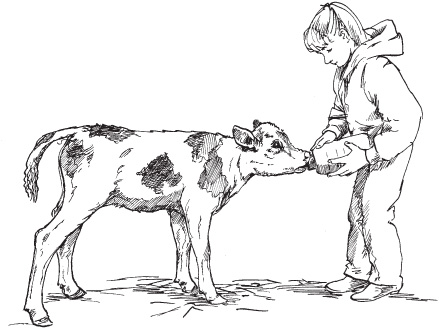
A newborn calf is more easily fed from a bottle if it has never nursed from its mother.
If you have no cow to provide milk for your calf, or you wish to use your cow’s milk for other purposes, milk replacer is available as a nutritional substitute for feeding young calves. A calf accepts milk replacer more readily when it is introduced gradually.
If you got some colostrum for your young calf, divide it into several feedings to get through the first day or two while you are teaching the calf to nurse from a bottle. If you cannot obtain colostrum, use whole milk, preferably raw milk from a dairy rather than pasteurized milk from a store. The calf will like the taste of raw whole milk better than that of milk replacer.
Before you run out of colostrum or milk, start mixing it with milk replacer to gradually adjust the calf to the taste of what she’ll drink from then on. If you switch suddenly to milk replacer, she may dislike the taste of the new stuff and be stubborn about accepting it.
You can buy milk replacer at a feed store. Of the many kinds and brands, some are better than others. Ask a dairy-man or your county Extension agent to recommend a good brand, and read the label to find out what the milk replacer contains.
Protein and fat content. The National Research Council recommends using a milk replacer with a minimum of 22 percent protein and 10 percent fat. But calves will do better if the milk replacer contains 15 to 20 percent fat; they will grow faster and be less apt to get scours from inadequate nutrition.
Fiber content. Check the fiber level in your milk replacer. Low fiber content (0.5 percent or less) is ideal because it means the replacer has more high-quality milk products and less filler.
Calf Feeding Program

Protein sources. Check the protein sources in a milk replacer. Are they milk-based or vegetable proteins? Milk protein is the highest quality and best for the calf, because the newborn calf has a simple stomach. Her rumen, for digesting roughages and fiber, is not working yet. She can digest and use protein from milk or milk by-products more easily and efficiently than she can use protein from plants.
Mixing milk replacer. Follow the directions on the bag. The powder is mixed with warm water and fed like milk. The recommended amount varies by brand.
The powder mixes better if you put the warm water into your container first and then add the replacer to the water and stir until it is all dissolved. It won’t mix quickly if the water is cool or lukewarm. Start with water that is a little hotter than you want it to be when you feed the calf; the temperature will be just right by the time you mix in the powder and take it out to feed the calf.
Storing milk replacer. Keep milk replacer powder dry and clean. It will spoil if it gets damp. Close the bag immediately after measuring out the correct amount. Keep it in a container with a tight cover. The quality may be reduced and the replacer may become contaminated with germs if the bag is left open and exposed to light, moisture, flies, and mice.
It’s just as bad to overfeed a calf as to underfeed. Too much milk can upset digestion and cause diarrhea. Feed your calf according to its size: A big calf needs more milk than a little one. Weigh or measure the milk to make sure you are not overfeeding the calf.
Feed 1 pound or about 1 pint (453 g or about 475 mL) of milk daily for each 10 pounds (4.5 kg) of body weight. Thus, a calf that weighs 90 pounds (41 kg) should get 9 pints (4.25 L) daily—4½ pints (just over 2 quarts)—in the morning and again in the evening, or about a gallon (3.75 L) a day.
Feed at the same time each day on a regular schedule so as to not upset the calf’s digestive system. If the calf gets diarrhea from being overfed, immediately halve the amount of milk for the next feeding. Then gradually increase it to the recommended amount for the calf’s size. As it grows, you can increase the amount of milk, but don’t feed more than 12 pounds (5.5 kg), or 1½ gallons (5.5 L), of milk daily.
Keep Feeding Equipment Clean
Always carefully wash your bottle or nipple bucket after each feeding; otherwise, bacteria will grow on it and may make the calf sick. Nipple buckets must be taken apart and cleaned. Use a bottle brush to thoroughly clean bottles.
If you are feeding more than one calf, a nipple bucket can save you time. Once a calf learns how to suck a bottle, you can switch it to a nipple bucket. You don’t have to hold the nipple bucket while the calf nurses. The bucket can be hung from a fence or a stall wall. Hang it a little higher than the calf’s head, where the calf can reach it easily.
Don’t enlarge the nipple hole on a nipple bucket. Some people widen it so the milk flows faster, decreasing the time the calf takes to drink the milk. But if the milk runs too fast, the calf may inhale some of it because it can’t swallow the milk fast enough. Milk in the lungs can lead to aspiration pneumonia, which can’t be cured with antibiotics and will kill the calf.
You can teach your calf to drink from a pail instead of a nipple bucket. Put fresh warm milk into a clean pail and back the calf into a corner. Straddle its neck and put two fingers into its mouth. While it is sucking your fingers, gently push its head down so its mouth goes into the milk. Spread your fingers so milk goes into the calf’s mouth as it sucks. After several swallows, remove your fingers. Repeat this procedure until the calf figures out that it can suck up the milk. A pail is easier to wash than a nipple bucket or a bottle.
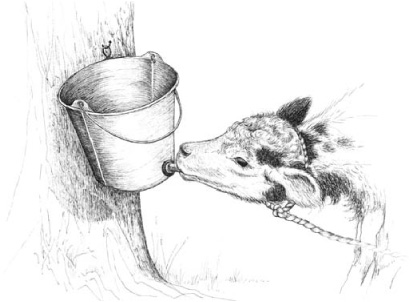
Feeding from a nipple bucket saves time, because you don’t have to hold it while the calf drinks.
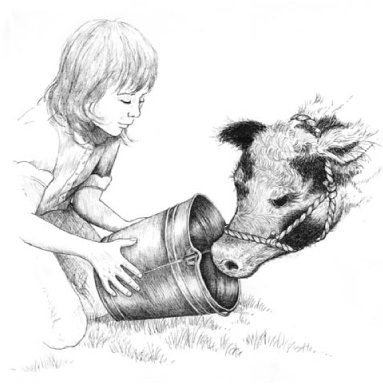
A calf needs help to learn to drink from a pail.
Get your calf to eat dry feed—hay and concentrates—as soon as possible. At first the calf won’t consume much dry feed, but it should learn how to eat it.
Hay. A growing calf needs roughages for fiber. A calf uses the bulkiness of roughage—hay, grass, corn silage, straw, and cornstalks—to develop its digestive system so its rumen can begin to function properly. A baby calf that can follow its mother’s example begins eating hay or grass at just a few days of age. But when a calf doesn’t have its mother to show it how to eat, you have to encourage it to eat hay. Put a little leafy alfalfa hay into its mouth after every milk feeding, until it learns to like it.
Give your calf hay as soon as it will start nibbling on it. Calves have small mouths and cannot handle coarse hay, but they will nibble on tender leafy hay. Fine alfalfa, clover, or grass hays—or a mix of these—are all nutritious. Give the calf just a little bit of fresh hay once or twice a day. Don’t give your calf much hay at one time, because the hay will be wasted; baby calves won’t eat hay that has been tromped or lain on.
Good green pasture is excellent feed for a calf, as long as it is getting some milk (or milk substitute) and grain. If the pasture is not top quality and lush, the calf may also need a little alfalfa hay, which has more protein and other necessary nutrients for the growing calf than mature or dried-out pasture. A calf that is penned without access to pasture definitely needs alfalfa hay as its roughage source.
Concentrates. A growing calf needs concentrates for energy. Concentrates are feeds that are high in nutrients relative to their bulk, and can be in the form of grains, starter pellets containing grains plus milk products, or a complete starter containing not only grains and milk products but also some roughage. Teach your calf to eat concentrates as soon as possible. Put some into its mouth after each feeding of milk until it learns to like it. You can then feed it in a tub or feed box.
Starter pellets have a high protein level, as well as providing the energy a calf needs for growing. The starter can be offered as early as the first week of life. A calf that will eat enough high-quality dry starter ration won’t need milk and can be weaned young. Early weaning can reduce costs if you are buying milk replacer. You can feed the calf alfalfa hay and starter pellets until the calf no longer needs the milk products. At that point you can transition the calf to grain and good hay or pasture.
Grains should be offered to the calf by the time it is 3 weeks of age. At first, about 1 cup or ¼ pound (236 mL or 125 g) of grain is all a young calf can eat each day. Increase the amount gradually until the calf is eating about 2 pounds (1 kg) of grain daily by the time it is 3 months old. Never wean a calf until it is eating about 2 pounds (1 kg) per day. After the calf has been weaned, continue feeding all the grain starter it will finish daily. By the time it is 3 to 4 months old, it may eat as much as 4 to 5 pounds (2 to 2.5 kg) of grain daily. A calf being fed a grain starter also should be given hay, and should be eating hay well for at least 1 week before weaning.
Complete starter works well if you don’t have a source of good-quality roughage for the calf; if you have alfalfa hay, you don’t need the complete starter. If you do use a complete starter, feed it free choice, meaning leave it available at all times and let the calf eat as much as it wants. Since complete starter includes roughage, the calf won’t need hay until it is about 3 months old. Before you discontinue the complete starter, give the calf some hay for at least two weeks, and make sure your calf is eating the hay well.
The Importance of Water
Make sure your calf has fresh, clean water every day and access to trace mineral salt. Calves need water, even though they get fluid with their milk or milk replacer. Water is especially important in hot weather.
Grain starter or a complete starter can be fed to a calf until it is 4 months of age to help it through the weaning process. A calf should eat at least 1 pound (500 g) of starter daily for every 100 pounds (45 kg) of body weight before it is weaned. Use a weight tape to estimate your calf’s weight.
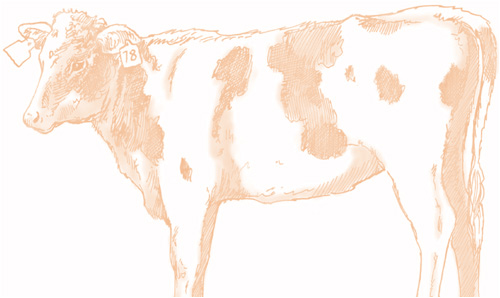
The age at which you wean your calf will depend on several things, including feed sources, the calf’s health, and how long it has been eating solid food. A calf can be weaned from milk when it is as young as 8 weeks, but most calves are weaned at the age of 3 months. A calf weaned before it is eating enough grain and hay won’t do well. It’s better for such a calf to stay on the nursing program longer.
Weaning is easier if the process is gradual. Start by decreasing the amount in its twice-daily bottle or bucket feedings. Cut back to about three-quarters of the amount you’ve been giving. Feed this reduced amount for a few days, and encourage the calf to eat more grain, feeding it right after it finishes its bottle or bucket. The calf will then be interested in the grain and not as upset with you for shortchanging on milk. Then go to one feeding of milk a day, giving grain at the other feeding time. Then stop the milk feedings. Give grain at the time of day when you used to offer the milk.
The rumen takes a while to enlarge so the calf can eat enough solid food to give it the nutrition it needs. Right after weaning, a calf still doesn’t have much rumen capacity. It may eat just a small amount of hay compared with the amount of grain it can handle. The amount of hay consumed will increase as the rumen develops further.
Don’t Wean Too Soon
It doesn’t hurt to keep a calf on milk or milk replacer for quite a while, but it does hurt to wean a calf too soon. Use your best judgment to decide when you think your calf is ready to be weaned.
After your calf is 3 months old and weaned, gradually change from feeding starter to a growing ration. A growing ration should contain at least 15 to 18 percent protein. If you have good pasture or alfalfa hay, the necessary protein can be supplied by supplementing pasture or hay with 4 to 5 pounds (2 to 2.5 kg) of daily grain.
Keep some hay in front of your calf all the time in a place it can easily reach. The hay should be fine stemmed and leafy, with no mold or dust. As the calf grows, hay can become a larger part of its diet. After it is 5 or 6 months old, good pasture can be used in place of hay.
A beef calf purchased from a cattle farmer will already have been weaned by its mother and will be accustomed to eating solid feed by the time you acquire it. When you bring the calf home, have feed and water in the pen.
Leave some good hay where the animal can find it easily, but not in a corner or along the fence line where the calf will walk on it every time it goes around the corral looking for a way out. Use really good grass hay or a mix of grass and alfalfa. Don’t give rich alfalfa hay to a newly acquired calf; it may make the animal sick or bloated. You can gradually adjust it to good alfalfa hay later.
Give it all the hay it will eat. Then slowly start it on grain, if you wish. Give the calf just a little bit until it learns to eat the grain, and then increase the amount gradually. Too much grain all at once may upset the calf’s digestion.
Give water in a water trough or in a bucket that is hooked to the fence or the stall wall so it can’t tip over. If the animal has never drunk from a bucket, you may have to put the bucket next to the feed, or feed the animal next to the water trough for the first day or two, so it will find the water when it comes to eat the hay.
Grassfed versus Grainfed
A weaned beef calf can be raised on roughages alone but will grow faster and get fatter sooner if you feed it grain. Some people prefer the flavor of grassfed beef and feel grainfed beef has too much fat. Others find grainfed beef to be more tender and juicy compared to grassfed beef. The eating quality of beef depends on many things besides taste preferences in beef, including the quality of forage during the finishing phase of grassfed beef and the age of the animal at finishing. Other factors include the animal’s age, length of time on grain or on high-quality forage, genetic differences in marbling ability, and whether or not the animal was gaining weight at the time of slaughter. An animal that is just maintaining weight or is losing weight, as well as an older animal past the age of 3 or 4, will generally be less tender.
Expected Finish Weight for a Beef Steer (in lbs./kg)

If your calf is a cross of two of these breeds, look at the figure where their charts meet. For instance, the top line shows the weights of Angus and Angus crosses. Heifers of the same breeds and crossbreds weigh about 80 percent of these values.
A beef steer generally weighs 1,000 to 1,300 pounds (454 to 590 kg) and has about 0.25 to 0.45 inch (6 to 11 mm) of outside fat at the time of slaughter. A beef heifer will finish at a lighter weight (about 900 to 1,000 pounds [408 to 454 kg]) than a steer of the same age will. A dairy steer’s finish weight depends on its breed. For instance, a Holstein steer might finish at 1,300 pounds (590 kg) while a Jersey steer might weigh 900 (408 kg).
Most beef animals eat about 7 pounds (3 kg) of feed to gain 1 pound (0.5 kg) of weight. To some extent, a calf’s rate of gain depends on its genetics; some cattle have better rates of gain than others. On average, a growing steer should gain 2 to 3 pounds (1 to 1.5 kg) per day. Some crossbred steers will gain more. Feed your calf 15 to 20 pounds (7 to 9 kg) of feed daily.
If your beef calf is a heifer, feed her as you would a steer. Remember, though, that she will not finish out as large as a steer of her same age and breed and therefore will not need as much feed. Adjust your feeding figures to fit her target finish weight.
By knowing the calf’s weight when you get it, and at what weight you want to butcher it, you can calculate the gain needed to get it ready for butcher. By knowing the total number of days until that time, you can determine the necessary average daily gain.
For example, if you buy a 500-pound (227 kg) steer in November and want to butcher him in August (270 days away), you can use the following formula to figure out how much your calf must gain per day to finish at 1,100 pounds (500 kg): Finish weight, minus present weight, divided by number of days until slaughter, equals the average daily gain. For example, 1,100 pounds (499 kg), minus 500 pounds (226 kg), divided by 270 days, equals 2.2 pounds (1 kg) for his necessary daily gain.
Good average daily gain for a steer is 2½ to 3 pounds (1 to 1.5 kg). The steer in the example should have no trouble meeting his finish weight. Good average daily gain for a young heifer is 1½ to 2 pounds (0.5 to 1 kg). Most dairy steers will gain somewhere between the two, although a Holstein may gain as well as a beef steer.
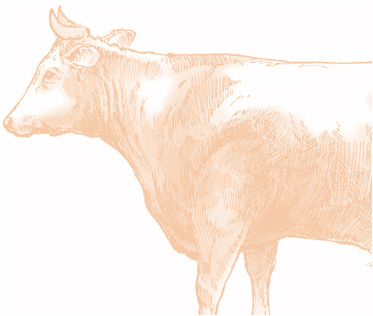
When you’re raising a calf to butcher, you will probably want to let it grow to good size. Some folks like baby beef (from a calf at weaning age), but if you have enough pasture to raise your calf through its second summer, you will get a lot more meat for your money by letting it grow bigger. The ideal age at which to butcher a steer or a heifer is 1½ to 2 years. At that age, the carcass is tender and is nearly as large as it will get.
The animal’s breed can be a factor in determining when it is ready to butcher. Beef animals generally do not marble until they reach puberty (or in the case of a steer, the age at which he would have reached puberty if he had been a bull). Different breeds mature at different ages. Angus and Angus-cross cattle often reach puberty at a younger age (and a smaller weight) than do larger-framed cattle, such as Simmental, Charolais, or Limousin.
An Angus-type beef calf may finish faster and be ready to butcher when it is a yearling or a little older. If you feed it longer, it may not get much bigger, just fatter. A Simmental calf, in contrast, may still be growing and not fill out (carry enough flesh to be in good butchering condition) until it is at least 2 years old.
Thus, the ideal age at which to butcher your beef animal depends on its breed and on whether it is grassfed or grainfed. Cattle will grow faster and finish more quickly on grain, but at greater cost. Whether you feed grain depends on personal preference (some people prefer grainfed beef to grassfinished beef, and vice versa) and your situation. If you have lots of pasture, raising grassfed beef is usually most economical.
You can take cattle to a custom packing plant to be slaughtered and butchered, or you can do the butchering yourself. A good resource on home butchering is Raising a Calf for Beef by Phyllis Hobson.
Can you save money raising your own beef? That depends on many factors, including the price of cattle in your area, whether you start out with a weaned or unweaned calf, whether you prefer grass-finished beef or grain-fed beef, the price you’re currently paying for beef, and whether you do your own butchering, cutting, and wrapping or have it done at a commercial slaughterhouse.
Weaned and grassfed. If you have adequate pasture for one or two calves, with fences that will reliably contain them, the simplest way to raise your own beef is to buy weaned calves or yearlings in the spring when your pastures are growing, then butcher them in the fall before your pasture is gone or its quality declines after freezing weather. If your pasture is good quality—if you can split the pasture into sections with electric fence and rotate the animals into new sections periodically to allow grazed areas to regrow—calves will gain nicely on grass. A yearling purchased in the spring can be easily finished on grass by fall, you won’t have the expense of hay or grain, and—assuming cattle prices don’t drastically change during the summer months—the value of the larger animal(s) in the fall will be more than you paid in the spring. On the other hand, a newly weaned calf may not be old enough or big enough to finish by fall and you would have to carry him over winter—feeding hay, or hay and grain—which greatly adds to the expense.
Marbling
Marketplace beef cattle carcasses are inspected by the U.S. Department of Agriculture and judged for quality, using several grades to rate the tenderness of the meat. The main thing that determines the grade is the amount of marbling—flecks of fat in the muscle—which makes the meat more tender, tasty, and juicy. The highest grade is prime, followed by choice, select, and standard. Prime has the most marbling; standard has little.
Unweaned dairy calf. If you purchase a day-old dairy or dairy cross calf to raise for beef, you’ll have the expense of milk replacer, starter pellets, hay, and grain until the calf is big enough to turn out on grass, and you’ll need to keep him through the next winter, feeding hay and possibly some grain. The exact cost of providing milk replacer, grain, hay, and so forth varies greatly, depending on the season, type of grain or hay, your location, and freight costs. The expense of raising a baby calf is partially offset by the fact your purchase price for a day-old calf (sometimes only $100 or less for a male dairy calf) will be much lower than the price for a beef weanling (500 to 600 pounds at $1.00 to $1.40 per pound—more or less, depending on its size and the market at the time of purchase) or yearling (700 to 900 pounds at $0.80 to $1.05 per pound, again depending on size and the market at time of purchase).
Your cow’s calf. The cheapest way to raise beef, if you keep a family milk cow, is to breed her each year to a beef bull and raise the crossbred calf to yearling size for butcher. Your cow then supplies you not only with milk but, after the initial growing period of her first calf to yearling age, she also furnishes enough beef each year to feed your family. By starting the calf with part of the cow’s milk, you won’t incur any additional feed costs for the calf’s first several months of life. After the calf is weaned, it can be grown on pasture and/or hay, and finished on pasture during its year-ling summer. Your only expenses are the stud fee for breeding to a bull (or, if the cow is bred AI, the breeding fee for the semen and technician’s time) and the cost of winter feed during each calf’s first year as a weanling.
When a cow starts giving milk at the beginning of a lactation cycle, the amount of milk she produces may increase so rapidly that her feed intake cannot keep up with her increased energy needs. The difference is mobilized from her body, causing the cow to lose weight, and a thin cow doesn’t produce much milk. Proper nutrition is therefore important in determining how much milk your cow will give.
About two-thirds of a dairy cow’s total nutrition should come from forages—that is, hay or pasture. Make sure the quality is good. Cows will eat a greater total volume of hay if you feed it fresh several times a day. The more good forage you can get a milk cow to eat, the more milk she will give.
Most backyard cows will more willingly stand for milking if given some grain while being milked and some may not even have to go into a barn but will just stand eating grain.
Some forage-based dairies rely on good-quality pasture and feed a minimum of grain, preferring to be satisfied with less volume of milk as a trade-off for a longer productive life of the cows. But grass-based dairies utilize topquality forage that is higher in nutrients than pasture that’s generally available to the backyard cow. Cows in a grass-based dairy are usually grazing across a lush field in strips, being moved to the next strip as often as three to four times per 24-hour period so they always have fresh forage containing optimum protein and energy and moved often so they will eat as much as possible.
Even though a dairy cow has a large rumen, she cannot eat enough forage to supply all of her nutritional needs. For good milk production, the dairy cow needs grain. Grain serves a dual purpose—besides providing the extra nutrition a cow needs, grain gives her a treat while she’s being milked. Most backyard cows will more willingly stand for milking if given some grain while being milked, and some may not even have to go into a barn or stanchion but will just stand eating grain.
The amount of grain must be adjusted to fit her needs: more during the peak of her lactation, when she is making the most milk, and less toward the end. How much grain a cow needs depends in part on the quality of her forage; a cow that’s expected to milk adequately while living in a weed patch will need more grain than a cow that enjoys good-quality pasture. The amount of grain a cow needs depends also on her breed, milk output, and the cow’s body condition. If she is becoming too thin to produce the milk, she needs more grain. If she is holding good flesh and still producing a satisfactory amount of milk she could probably get by with a minimum amount. Just keep her happy while she’s being milked, make sure she has good pasture or hay, and increase the grain ration if she loses weight.
Your cow needs a constant supply of clean water. A milking cow needs 3 to 5 gallons (11 to 19 L) of water, including the moisture in her feed, for every gallon (4 L) of milk she produces. A cow eating hay needs to drink more than a cow on lush green pasture, which contains a lot of moisture.
When done correctly, milking is a pleasurable experience for both the cow and the person milking her. You—and your cow—may need a few tries before you feel completely comfortable with the task. Just remember to be gentle and observant when milking, and keep the following tips in mind.
Short fingernails, clean hands. Before milking your cow, make sure your fingernails aren’t long. If you poke the cow’s teat with a sharp fingernail, she may kick. Wash your hands as well.
Check and clean the udder. The cow’s udder is a complex structure that needs good care. Before you start milking, check the udder for problems or injuries. Then check for abnormal milk by squirting a little into a small bowl. If the udder and the milk are fine, wash the udder with a sanitary solution (obtained from your vet or a dairy supplier) mixed with warm water. Remove any dirt on the teats so it won’t get into the milk. Washing the udder with warm water also stimulates the cow to relax and let down her milk. Use a clean paper towel to wash and dry the udder and teats before you milk.
Make yourself comfortable on a stool beside the cow’s udder. Hold a clean empty seamless stainless steel bucket between your legs. Start with two teats—the front teats or the back ones, or two on the same side. Hold one teat in each hand and squeeze one at a time, squeezing the milk down and out through the teat opening. Begin the squeeze at the top of the teat, with your index finger and thumb grip. Finish the squeeze with the lower fingers. By applying pressure with your thumb and index finger, you keep the milk from going back up the teat, so when you squeeze with the rest of your fingers, the milk comes down and out through the hole.
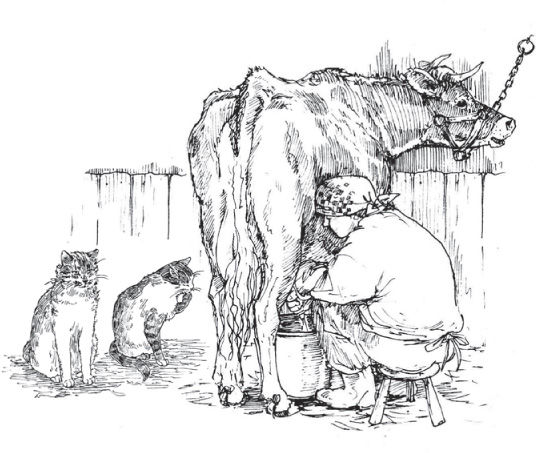
When you get good at milking you can easily aim a squirt in the direction of a barn cat waiting to catch the milk in its mouth.
Aim the stream of milk into the bucket; don’t let it squirt off to one side. When you become good at milking, you can easily direct the stream and even aim a squirt toward a barn cat waiting to catch the milk in its mouth.
After each squirt, release your grip. More milk will flow down into the teat. Keep up a nice rhythm by alternating squirts. When the first two teats are soft and flat and you can’t get any more milk from them, milk out the other two quarters. If one quarter seems to have more milk than another, perhaps one of your hands is not yet as strong as the other and you aren’t getting quite as much milk out with each squeeze.
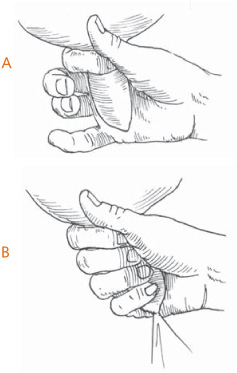
To milk, apply pressure with your thumb and index finger (A) while squeezing with your lower fingers (B).
Cows can let down or hold up their milk. No milk is in the teat until the cow lets it down, which she does by relaxing muscles that keep the teat canal closed. When a cow wants her calf to nurse, or thinks it is milking time, she lets the milk flow down from the udder into the teat. If a cow doesn’t want to let down her milk, you won’t get much milk out of her. Washing and massaging may encourage a stubborn cow to release her milk.
Before you begin milking, you should be aware of the following.
Sometimes a cow’s udder is so sore right after calving that she doesn’t want you to touch it. She may kick at her calf as you try to help it nurse, or kick at you when you try to milk. In this case, press your head firmly into her flank as you milk to prevent her from swinging that leg forward. Try for the area right in front of the stifle joint. If you press hard every time you feel her tensing up to kick, she won’t be able to kick well. If a cow is nervous the first few times you milk her, talk softly to her or hum a little to reassure her and keep her relaxed.
Sometimes a cow will kick if her teats get sore and cracked, as they may do in cold weather. If they get too cracked, they will bleed. To prevent chapping on teats, rub a little ointment (such as Bag Balm) on the teats after you finish each milking.
Once you get used to the proper squeezing motion and rhythm, milking is easy. But milking uses muscles in your forearms and hands you may not have used much, and they will get tired. Your arms and hands may ache afterward. The more often you milk, the stronger your arms and your grip will get.
Some cows are easy to milk. They have teats that are easy to hold on to, and they let their milk down freely. The milk almost flows from the udder into your bucket. Other cows are harder to milk. More effort is needed to squeeze out the milk, and milking takes longer. A cow with short teats may be a difficult milker because getting a good hold is more difficult. More time is needed to milk if you must squeeze with just one or two fingers instead of with your whole hand.
Bacteria sometimes enter the udder through the teat canal. In the warm environment inside the udder they multiply rapidly and cause infection, resulting in mastitis. The cow’s body sends white blood cells to fight the infection. The infected quarter is swollen and often feels hot. If a quarter has abnormal milk—if it is lumpy, watery, or bloody or has any other abnormality—or heat and swelling, treat the cow for mastitis. A cow with mastitis may show no other symptoms.
You can test milk for mastitis by using the California Mastitis Testing kit, which measures the amount of somatic cells in the milk. Somatic cells are white blood cells and mammary cells that have been damaged by infection. The somatic cell count in the milk will be high as long as the quarter is infected. A test kit comes with complete instructions and is available from most dairy supply companies.
Your vet can provide antibiotic preparations to treat mastitis or you can buy antibiotic tubes at your farm store. Before giving the medication, thoroughly milk out the quarter. To administer the medication, gently insert a syringe tube with a long plastic tip into the teat and squirt the antibiotic up into the quarter. Gently massage the treated quarter to help spread the antibiotic to all parts. Follow directions on the label for proper use and the number of days of treatment. Call your vet if you notice any of the following symptoms:
• The mastitis does not clear rapidly; you may need to have a milk sample cultured to find out which organism is the culprit and what type of antibiotics it is most sensitive to.
• The cow shows signs of systemic illness, such as being off feed, acting dully, or having a fever.
Not Safe for Humans
Milk from an infected cow should not be consumed by humans. Even after the infection is cleared up, the milk can’t be used until it contains no more antibiotic. The label on the medication tells how long the antibiotic persists in the cow’s milk. While the cow has mastitis, keep milking her regularly to hasten her recovery. In most cases, the milk from a recovering cow can be fed to calves. Consult your vet for guidance.
Take care to keep milk clean. Use a clean bucket, a clean strainer, and clean storage containers. After each use, rinse all equipment in warm water to remove the milk fat. Then scrub everything with hot water and dishwashing soap, using a stiff plastic brush. The brush will clean the equipment much better than a dishcloth. Always use a plastic brush or plastic scouring pad rather than metal; metal leaves scratches on the surface of the equipment where bacteria can cling. Rinse everything thoroughly in clean water.
If you wish, you can pasteurize your milk to make sure it is perfectly safe to drink. (The milk you buy at the grocery store is pasteurized.) Pasteurized milk is heated to a specific temperature, kept there for a short time, and then quickly cooled. A home pasteurizing unit can be purchased from a dairy supply catalog. It consists of a metal container with a heating element in the bottom. Fill the container with water, set a gallon (4 L) of milk in a covered metal pail into the water, and then plug in the unit. The water heats to the desired temperature for the proper time, and a buzzer sounds when it’s done. (See page 208 for instructions for pasteurizing milk without an electric unit; cow milk can be pasteurized in the same manner as goat milk.)
Can you save money by milking your own cow? That depends on how much you pay for the cow—though the expense is spread over her lifetime and also is part of the cost of getting a calf each year to sell or raise for beef—the price of feed (which varies considerably with type, season, and location), how much milk she produces, and how much you are currently paying for your family’s supply of milk.
During the summer months your cow may milk adequately on good pasture with just a little grain fed at milking time. A family milk cow on good pasture often does fine on 2 to 3 pounds (1 to 1.5 kg) of grain per milking. During winter months when grazing is sparse or nonexistent, however, she will need good-quality hay—preferably legume hay while she is still lactating. Your hay costs can be minimized if you dry her up during winter, giving her at least two months of rest before her next calf. She won’t need as much quantity or quality of hay while she is dry. If you plan her calving date for spring, she will have green grass (your cheapest feed) during her peak lactation. By purchasing a young cow, you will have her milk and calves for a dozen years or more, making the purchase price a good investment.
Milking Schedule
A cow should be milked twice a day, 12 hours apart. Not sticking to this schedule can be harmful to the cow.
To keep the milk flowing in the future, your cow will need to be rebred about three months after she gives birth to her calf. Keep track of her periods of heat when she starts cycling again, so you can have her bred at the proper time. It may be several weeks before she starts having heat cycles.
A few weeks or months after breeding, have your veterinarian check her for pregnancy if she hasn’t returned to heat. It helps to know if she is actually pregnant—sometimes a cow will lose the pregnancy early on but won’t return to heat—and when to expect her calf to arrive the next year, so you can plan to dry her up on time before her next calving. If she is not pregnant, you must try to get her rebred.
A cow can be bred only when she comes into heat, or estrus. If she is to be bred by artificial insemination (AI), you must be able to determine when she comes into heat, and then have a technician insert a capsule of semen into her uterus at the proper time. Determining when your cow is in heat can be difficult if no other cattle are around. Signs of heat include increased restlessness, pacing the fence or bawling, or a mucous discharge from the vulva. However, not all cows show obvious signs. One clue is that milk production usually decreases temporarily on the day the cow is in heat.
Keep a Record of Heat Cycles
When your cow starts cycling, keep a record of her heat periods, which are usually three weeks apart, so you’ll know when she should be bred. If you keep good records, you’ll be less likely to miss the period during which you want her bred in order for her to calve at the best time of the year for your climate.
If the cow is living with other cattle, telling when she comes into heat is easier. The other cattle will mount her, or she will mount them even if no bull is present. The hair over her tail and hips may be ruffled from this activity. The easiest way to tell is to put her with another cow, heifer, or steer for a short time. If you don’t have any other cattle, take her where she can be left with a bull for one to three weeks until she is bred. The bull will know when she is in heat.
Parts of a Cow’s Reproductive System
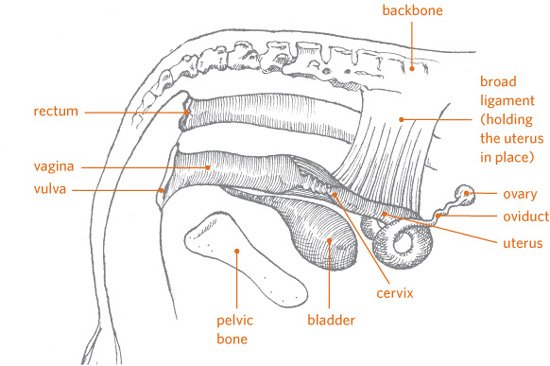
Breed your cow to the best bull available. If your cow is a registered purebred and you want a purebred calf that you can register, she must be bred to a registered bull of the same breed. When a dairy cow is mated to a good bull of her breed and her calf is a heifer, the calf will be worth more.
The nice thing about breeding your cow by AI is that you can select an outstanding bull from anywhere in the United States. You have your pick of the best bulls in the breed. These bulls are kept in central locations called bull studs. Get a catalog from one of the major bull studs. Your AI technician can obtain one for you.
If your cow is a crossbred or if you want to raise a crossbred calf, choose a bull of a different breed or a crossbred bull. A crossbred beef-dairy calf makes a good beef calf if you plan to have it butchered.
If you bought your cow from a local cattleman, you might ask him if he would consider putting her with a bull at his place, and what he would charge. Or you may have a neighbor with a bull who is amenable to breeding him with your cow. Ask the bull’s owner to keep track of the breeding date so you’ll have it for your records. With this information, you can predict your cow’s calving date the next spring.
Duration of Pregnancy
The duration of gestation is about 285 days, but a cow may calve as much as 9 days before or after her due date. Most cows calve within 3 or 4 days of their due dates.
Using AI, a large number of cows can be bred to one bull. The bull’s semen is collected, divided into many small portions, and put into tubes called straws. The straws are stored in liquid nitrogen, which keeps them at the cold temperature of –320°F (–195°C). The frozen straws can be shipped anywhere, using semen tanks that keep them frozen.
If you can tell when your cow is having heat cycles, you can have her bred by AI. Talk with your local AI technician about ordering semen from a bull of your chosen breed. Several breeding services collect semen from champion bulls all across the United States. Some ranchers and most dairymen use AI instead of buying bulls.
The price of semen varies. Some bulls, especially the most popular champions in their breed, are expensive. You don’t need the most expensive semen. Choose the sire ahead of time and make arrangements with the AI technician so you can purchase the semen and have your cow inseminated at the proper time.
Watch your cow closely to tell when she comes into heat. She will probably be in heat for 12 to 18 hours. Try to spend at least 30 minutes twice a day, morning and evening, watching her for signs of heat. (You may not need to spend this much time if she gives obvious clues.) When you see that she is in heat, call the AI technician.
While your cow is restrained in a chute, the semen is inserted into her uterus through the vagina. With good luck, she will settle, or become pregnant. If she does not conceive, she will return to heat 17 to 25 days later and can be bred again.
Size of Fetus during Pregnancy
At 2 months, the fetus is the size of a mouse. By 5 months, it’s the size of a large cat. After the fifth month, the fetus will be large enough that you may be able to see or feel it kicking. The cow’s right side may ripple and move. As you lean your head against the cow’s right flank during milking, you may feel a bump from a small foot. After the fifth month the fetus grows rapidly, becoming calf-size by 9 months.
Once your cow is bred, watch her closely for the next few weeks, especially during the time she would have her next heat period. If she does not come into heat at that time, she’s probably pregnant. To make sure, have your vet check her for pregnancy two or three months after the breeding.
Your cow should be on a vaccination schedule in which she receives booster shots for certain diseases once or twice a year. Some vaccines can be given during pregnancy, but others should not. Talk with your vet about the vaccinations your cow needs.
Also ask the vet about a vaccination to help protect your cow’s calf against scours (infectious diarrhea). If your pens or pastures have held baby calves and have been contaminated with calf diarrhea, vaccinating your cow against scours will create antibodies against many of the diseases that cause scours. She will pass the antibodies on to her calf when he nurses.
To get ready for the new calf and new milk production, the cow’s body needs a rest from making milk. Allow her to go dry for a couple of months before her next calving. The length of the dry period varies depending on the cow’s age and condition. She needs at least 45 days of rest to be able to produce a lot of milk during her next lactation and to make enough antibodies in her colostrum for the next calf. A six- or seven-week dry period is adequate for the average cow. But young cows calving for the second time and high-producing cows generally need eight weeks (56 to 60 days).
To dry up a cow, simply stop milking her. The transition should be abrupt; don’t try to ease the cow into it by partial milking. Cows are designed to stop producing milk when the udder is full and tight, which is what happens under natural conditions when a calf is weaned or dies. The pressure in a cow’s udder signals her body to stop making milk. She will be uncomfortable at first, but after a few days the pressure will ease. Her body gradually resorbs the milk left in her udder.
To help a cow dry up, reduce her feed, especially grain. Eliminating grain helps the cow’s body adjust to not making milk. Pasture or hay should provide enough nutrition for your cow to go through the dry period without becoming fat. She will need grain only if she needs to gain weight. If she is in good condition at calving time, she will produce milk well. If she is thin, she won’t be able to milk as well as she should, and she’ll have trouble rebreeding on schedule.
Check your cow’s udder closely while she is drying up. After the last milking, treat each quarter with an antibiotic recommended by your vet to help prevent mastitis. Watch for heat or swelling in the udder.
Vaccinate Before Rebreeding
Before rebreeding your cow, vaccinate her against leptospirosis, infectious bovine rhinotracheitis, bovine virus diarrhea, and other diseases as recommended by your veterinarian. Vaccinate at least three weeks before rebreeding. Some of the live virus vaccines (such as infectious bovine rhinotracheitis or bovine virus diarrhea) may cause abortions in a cow if given while she is pregnant. Also the cow needs time to build immunities against these diseases before she becomes pregnant, since some of these diseases can cause abortions.
As calving time approaches, your cow will get a large belly and become clumsy. She should be in a safe place where she won’t slip on ice or get stuck in a ditch. Make sure you have a good place for your cow to calve. A shed in her pen or pasture will work if the weather is cold, wet, or windy. If she is confined in a pen or a barn, make sure she has clean bedding. A calf that is born in an unclean place may get an infection.
If your cow is calving in summer and the weather is nice, she can calve at pasture if you check her often. Be sure the pasture is safe and clean, and covered with grass rather than dirt or mud. She should have shade if the weather is hot, no gullies or ditches to get stuck in, and strong fences she can’t crawl through when she becomes restless during early labor.
If your cow will have her calf in the barn, put lime onto the barn floor before covering it with new bedding. The lime not only helps disinfect the floor but also makes a nonslippery base. The floor must provide good footing so the calf will be able to stand up and the cow won’t injure herself. She’ll be getting up and down during labor, and you don’t want her to slip and injure her legs or damage her udder.
The stall should be large and roomy. If the stall is too small, the cow may lie too close to the wall, and the calf may get jammed into the wall as it emerges.
Make sure the bedding is clean. Never use wet sawdust, moldy straw, or any damp, moldy, dusty material. Many cases of mastitis are caused by dirty bedding. Wet or dirty bedding containing mold or manure will have germs that can invade the uterus or udder of the calving cow or infect the calf’s navel.
Early labor may last two or three hours (a heifer having her first calf may experience early labor for four to six hours or even longer).
Things to Have on Hand at Calving Time
• Halter and rope in case you need to tie the cow
• Tamed iodine (Betadine) or chlorhexidine solution in a small, widemouthed jar, for dipping the calf’s navel
• Towels for drying the calf
• Bottle and lamb nipple, in case you need to feed the calf
• Obstetric chains or short, small-diameter (½ inch [1 cm]), smooth nylon rope with a loop at each end, in case you need to pull the calf
• Disposable obstetric gloves (from your vet) and lubricant (obstetric “soap”) in a squeeze bottle
• Flashlight for checking on your cow at night
As your cow approaches calving, her udder gets full. The vulva becomes large and flabby; the muscles are relaxing so they can stretch when the calf comes through. The area between the cow’s tailhead and pinbones becomes loose and sunken. These changes may start several weeks or just a few days before she calves. Her teats may fill with milk, or milk may leak from the teats. Every cow is a little different, so be alert, observant, and ready. If your cow is with other cattle, put her into a separate pen so they can’t bother her when she calves.
The process of calving has two stages. Knowing what occurs at each stage will help you decide when or if your cow needs help.
The signs of early labor are restlessness and mild discomfort. The cow has a few early uterine contractions as the uterus prepares to push the calf out. She may kick at her belly or switch her tail.
Contractions become more frequent and more intense as labor progresses. The contractions of early labor usually help turn the calf toward the birth canal.
Early labor may last two or three hours (a heifer having her first calf may experience early labor for four to six hours or even longer). She will get restless and may pace the fence. If she is at pasture, she may go into the bushes or a secluded corner.
When the cervix is fully open and the calf or the water sac—which often precedes the calf—starts into the birth canal, active labor has begun. The birth should take place in 30 minutes to 2 hours.
The water sac is dark and purplish. When it breaks, dark yellow fluid rushes out. If the sac breaks before it comes out, all you’ll see is fluid pouring from the vulva. The water sac should not be confused with the amnion, a white sac full of thick, clear fluid. The amnion protects the calf while it is in the uterus.
Active labor is more intense than early labor. The cow has strong abdominal contractions. The entrance of the calf into the birth canal stimulates hard straining. Each contraction forces the calf farther along. The calf’s feet soon appear at the vulva. Although the calf can safely remain in this position for a couple of hours, it is best if it is born within one hour. Give the cow time to stretch her tissues, however; helping her out by pulling on the calf too soon may injure her.
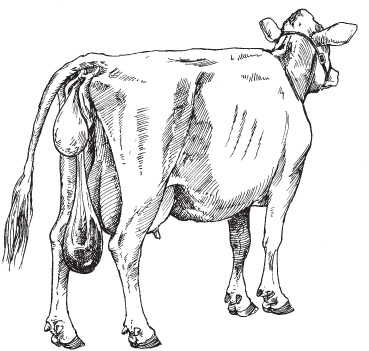
As the cow prepares to give birth, the water sac often emerges first.
Your cow can get up and down a lot in early labor, but once she starts straining hard, she will probably stay down. Make sure she doesn’t lie with her hindquarters against the fence or the stall wall.
Passing the calf’s head may take a while, but as long as the cow is making progress, you won’t need to help. After the head emerges, the rest of the calf usually comes easily. Fluid will flow from the calf’s mouth and nostrils as its rib cage is squeezed through the cow’s pelvis. This fluid was in the calf’s air passages while it floated around in the uterus, and it comes out now so it can start to breathe.
After the calf is born, the cow may rest for a few minutes; labor is hard, and she may be tired. But the calf must begin breathing immediately. If it doesn’t, or if the sac over its head does not break and is still full of fluids, you must quickly help. Pull the sac away from its nose. Clear the fluid away and make sure the calf starts breathing. The cow will probably turn to see her new calf. She should sniff at it and then start to lick it.
When the cow gets up after calving, a lot of red tissue will be hanging from her vulva. This mass is the placenta, which surrounded the calf and is attached it to the uterus with buttons—dark red, dollar-sized attachments spaced over the uterus. The afterbirth may take 30 minutes to a few hours to completely detach from her uterus and come out. Never pull on the afterbirth while it is still hanging from the cow. If she doesn’t shed the afterbirth for many hours, call the vet. Cows eat their afterbirth so it won’t attract predators; watch for the afterbirth to detach, and remove it from your cow’s pen right away so she won’t choke on it.
If the cow takes longer than 10 hours to shed the afterbirth, she may develop a uterine infection. Keep a close watch for pus discharge or illness, which are signs of infection. If your cow won’t eat or develops a fever, she’ll need immediate treatment. Call the veterinarian.
You may need to help with the birth. The calf may be positioned wrong in the uterus so it cannot enter the birth canal or come through it. The calf may be a bit too big to pass through easily, or maybe your cow has twins. A normal calf should be born within one hour of the start of second-stage labor. If a cow is too long at labor and nothing is happening, have her checked by your veterinarian or another experienced person. Definitely call for help if you see only one foot or hind feet coming out.
Your help will most often be needed for birthing twins, because they may be tangled together, and bull calves, because they are bigger than heifer calves.
Many calving problems can be corrected if someone is there to help. When a cow goes into labor, check on her frequently to make sure the birth is progressing normally. All too often, assistance is given only after the cow or the calf is in critical condition. Be on hand so you can give or get help quickly.
During a problem birth, a careful examination inside the cow may be necessary. If your cow is gentle, you can check her. First, tie her up so that she can’t move around. If she’s lying down and won’t get up, check her where she is. Work as cleanly as possible to avoid introducing infection into her. If possible, use a disposable long-sleeved plastic glove that covers your whole arm. If nothing has yet appeared at the vulva, reach into the birth canal to see whether you can feel two feet. If you feel just one foot, or some other abnormality, you’ll know why the birth is not progressing.
If no feet have come into the birth canal, reach farther in and examine the cervix. If it is not opening yet, you are interfering too soon. A cervix that is completely open will be 6 to 7 inches (15.5 to 18 cm) wide, and you can easily reach into the uterus.
If the calf is not positioned correctly, the first part of it you touch may be its head, tail, foot, or some other part of its body. In that case, you will need immediate help to reposition the calf so it can be born.
Often, the only problem is that the calf is a little too big and needs a pull. But don’t pull on a calf unless it is in perfect position to come out. If the feet have been showing for an hour and you’ve felt inside the vulva to make sure the nose is right there and the head is advancing properly, pull the calf.
If the calf’s nose is showing and the cow’s straining starts to push the head out, you can wait. But if she isn’t making progress after the feet have been showing for one hour, you should help her. First, feel inside the birth canal to see if the head has room to pass through the cow’s pelvic opening. If you cannot get your fingers between the top of the calf’s head and the top of the birth canal, the opening may be too small. If that’s the case, call a vet.
If you think the head can come through, go ahead and pull on the calf’s legs. Having two people working as a team to pull the calf makes the job easier. Pull alternately on one leg and then the other to ease the calf through the pelvis one shoulder at a time.
The calf has to come out in an arc. When its feet emerge from the vulva, pull straight out. But after the head comes out, pull slightly downward, more toward the cow’s hocks, as its body arches up over the pelvis and then down. If you watch a normal birth, you’ll notice that the calf curves around toward the cow’s hind legs as she is lying there and it slides out.
In a difficult birth, one person can pull on the front legs with obstetric chains or ropes secured around the calf’s legs above the fetlock joints, so they won’t injure the joints or the feet. At the same time, the other person stretches the cow’s vulva (see drawing below). Stretching the vulva helps the head come through more easily. One person pulls while the other stands beside the cow if she’s up, or sits beside her hips if she’s down, facing to the rear. If you are the one doing the stretching, put your fingers between the calf’s head and the cow’s vulva, pulling and stretching the vulva each time the cow strains. You and your partner should pull and stretch the vulva only when she strains, and rest while she rests. Don’t pull when she is not straining.
Pulling a Calf
In a difficult birth, you may need to help out by stretching the vulva and pulling the calf using obstetric chains or ropes looped around the calf’s legs above the fetlock joints. Pull only when the cow strains. Do not pull when she is not straining.
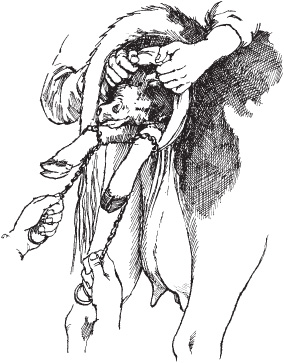
Try to recognize problems early and get help before the cow or the calf is in serious trouble. When you are in doubt about a situation or unsure of your ability to handle it, call the vet or an experienced cattleman or dairyman.
Sometimes in a hard birth, you get the calf partly out, only to have it stop at the hips. Don’t panic. Remember the calf has to come up and over the pelvic bones in an arc. As the calf’s body comes out, start pulling downward, toward the cow’s hind legs. To avoid hurting the calf’s ribs, get it out far enough that its rib cage is free before you pull hard downward. Once its rib cage is out, the calf can start to breathe if the umbilical cord pinches off.
If the cow is standing, pull straight downward and underneath her, pulling the calf between her hind legs, which raises the calf’s hips higher, to where the pelvic opening is the widest. If the cow is lying down, pull the calf between her hind legs, toward her belly.
A calf coming backward, with hind feet protruding from the vulva, has its heels up. Front legs have the toes pointing down. If the bottoms of the feet are up, the calf may be backward. Before you assume that, reach inside the birth canal to see whether you feel knees (front legs) or hocks (hind legs). The calf can be rotated just a little sideways or upside down. If the calf is backward, call the vet quickly to help you. He will use a calf puller to get the calf out before it suffocates.
A breech calf is positioned backward, but the legs do not enter the birth canal; he is trying to come rump first. The cow may not start second-stage labor at all. Nothing is in the birth canal to stimulate hard straining, and she seems to be too long in early labor. If you wait too long before checking, the placenta will eventually detach and the calf will die. If you check inside her, all you’ll feel is the calf’s rump or tail. Call the vet.
Sometimes one of the calf’s front legs will be turned back. One foot will appear but not the other, or sometimes the head and one front foot will show. If you can detect this problem early, before the head is pushed out far, you can push the calf back into the uterus, rearrange it, and get the other leg unbent and coming properly. Otherwise, get help immediately.
After a difficult delivery, make sure the calf starts breathing as soon as possible. Stimulate it to breathe by sticking a clean piece of straw or hay up one nostril to make it sneeze and cough. If you get no response, give the calf artificial respiration. If it is still alive, you can feel its heartbeat near the rib cage, on the left side, behind its front leg. Blow a full breath of air into one nostril, holding the other nostril and its mouth closed with your hand. Blow until you see the calf’s chest rise, then let the air come back out on its own. Blow in another breath, and keep breathing for the calf until it regains consciousness and starts breathing on its own.
Some calves are still encased in the amnion and its fluids after sliding out. If the sac doesn’t break, the calf will die because it cannot breathe. This is a very good reason to be on hand when your cow calves.
Once the calf is born, the cow should get up soon and start licking it. The licking stimulates the calf’s circulation and encourages it to try to get up and nurse. If possible, let the cow lick the calf dry. If the weather is cold and the cow is not licking, rub the calf with clean towels.
Navel ill is a serious infection that can kill or cripple a calf. Bacteria that enter through the navel may create an abscess in the navel area or may get into the bloodstream and cause a general infection called septicemia, which can be fatal. Or the bacteria may settle in the joints. Even with diligent treatment, it can be difficult to save a calf once it gets navel ill.
Disinfect the calf’s navel stump as soon as the umbilical cord is broken and you have made sure the calf is breathing. Have a widemouthed plastic container (such as a yogurt container) ready ahead of time, containing ½ inch (1.5 cm) of tamed iodine or chlorhexidine. Immerse the navel stump in the iodine by holding the jar tightly against the calf’s belly and making sure the navel cord is thoroughly soaked in the iodine.
The iodine not only kills germs but also acts as an astringent, shrinking the tissues and helping the navel stump dry up quickly and seal off so that bacteria cannot enter the calf. Don’t touch the navel cord with your hands unless they are really clean. You need to touch the navel cord only if it drags on the ground when the calf is standing up. In that case, cut it with clean, sharp scissors; leave a 3-inch (7.5 cm) stump and be careful not to pull on it. Pulling or jerking on the cord can injure the calf internally. As soon as you cut the cord, immediately soak the navel stump in iodine.
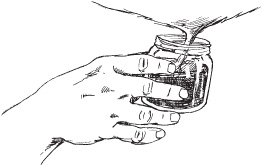
To disinfect a newborn’s navel stump, use a small jar containing tamed iodine (Betadine) or chlorhexidine (Nolvasan) solution.
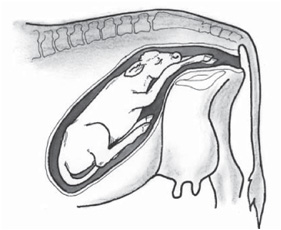
Normal birth position.
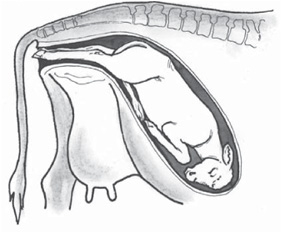
Posterior presentation. Birth is usually too slow to result in a live calf unless assisted.
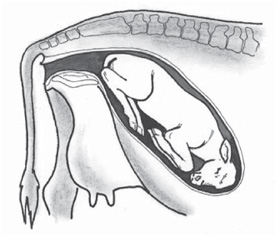
Breech. The calf must be pushed forward far enough so each hind leg can be tightly flexed at the hock and brought into the birth canal.
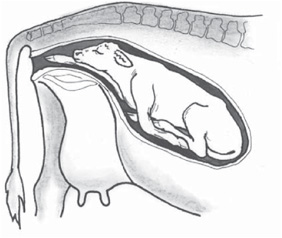
One front leg turned back. The calf must be pushed back and the leg brought into the birth canal.
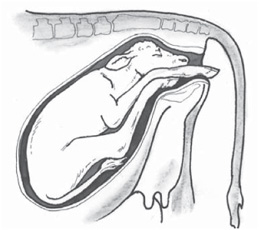
All four feet coming into the birth canal. The calf must be pushed back far enough to push the hind legs back over the pelvic rim and into the uterus.
The navel stump of a baby heifer usually dries up after just one application of iodine. But a bull calf’s stump may take longer. Baby bulls urinate close to the navel, and if they urinate while lying down, as they often do, the navel stump gets wet repeatedly and doesn’t dry up quickly. While it is still wet, bacteria can enter it. Reapply the iodine a few hours later, and again if necessary, to dry up the stump within the first two hours after birth.
Also give the new calf an injection of vitamin A, if recommended by your vet, and any necessary medications. In some areas, newborn calves need selenium to prevent white muscle disease. You may need to vaccinate newborns against enterotoxemia (a highly fatal gut infection) or tetanus. Discuss your calves’ vaccination needs with your vet ahead of time.
Colostrum, the cow’s first milk, has twice the calories of ordinary milk, with rich, creamy fat that is easily digested and high in energy. Colostrum helps the calf pass its first bowel movements. Most important to the calf are the antibodies in the colostrum that provide immunity to disease. This temporary immunity lasts several weeks, until its immune system starts making its own antibodies. A calf that gets no colostrum or that doesn’t nurse until it is several hours old may develop scours or pneumonia.
The best time for the calf to absorb antibodies is during the first two hours (and preferably the first 30 minutes) after birth. Make sure the calf is up and nursing within one hour of birth. If it can’t stand up on its own within that crucial time, help the calf, or milk a little out of your cow’s udder and feed it to the calf with a bottle. Before the calf first nurses, wash the cow’s udder and teats well with warm water.
If you weren’t there when the calf was born, don’t assume that it nursed well just because it is with the cow. To make sure it gets an adequate amount of colostrum, try to get the calf to nurse as soon as you arrive on the scene.
Without help, most calves will eventually manage to nurse, but some won’t, because they have a hard time getting onto teats. This problem is especially likely if the cow has a low udder or the teats are full and big. If too much time passes before a calf nurses, it will not absorb enough antibodies because its gut lining loses the ability to absorb colostral antibodies after the first couple of hours of life.
A calf can be fed for several days with the colostrum you milk from your cow. But people cannot drink the milk until it no longer has colostrum in it. You must milk the cow at least twice a day to get the remaining colostrum out of her udder and hasten the production of regular milk. The milk will be ready to be used by people in four to seven days.
True colostrum, the undiluted first milk, is obtained only from the first milking or nursing. The calf needs this first milk immediately after it is born. Later milkings produce transitional milk, a mixture of colostrum and regular milk. It is mostly colostrum at first but becomes more and more diluted by regular milk with time, until no more colostrum is left in the udder.
Heat Stress
If the weather is hot when your cow calves, make sure she and the newborn are in the shade. Heat stress can reduce the immunity the calf receives from colostrum, making it more susceptible to diseases.
The colostrum is thicker and richer than regular milk and is usually yellow and sticky. It is waxy when cold. One indication that milk still has colostrum is that it will not easily go through a strainer.
If a cow’s colostrum is not good—if it is bloody or she has mastitis—her newborn calf should be fed colostrum from another cow. A 90-pound (41 kg) calf, such as a Holstein, needs about 3 quarts (3 L) of colostrum at its first feeding right after birth. A 50-pound calf (23 kg) should receive 1½ quarts (1.5 L).
If a cow has a lot of colostrum when she calves, you can milk a quart (1 L) from her while her own calf is nursing and store it in a plastic container or milk carton. This extra colostrum can be saved for emergencies, such as when a cow has poor colostrum or dies during birth. Extra colostrum will keep for up to one week in the refrigerator and for several years in the freezer.
If the newborn calf has trouble nursing or is too weak to stand and nurse after a difficult birth, milk colostrum from its mother to feed it. You’ll need about a quart (1 L) to get it started. Pour the colostrum into a small-necked bottle (one that a lamb nipple will fit) and feed it to the calf. This bit of colostrum will usually give the calf strength to get up and nurse. If the calf is too weak to suck a bottle for its first nursing you will need to use an esophageal feeder.
Learn to Use an Esophageal Feeder
An esophageal feeder is a handy way to get fluids into a calf that is too weak or sick to nurse. The esophageal feeder is a container attached to a tube or stainless steel probe that goes down the calf’s throat and into the stomach. Get an esophageal feeder from your vet, and ask the vet or other experienced person to show you how to put the feeding tube down a calf’s throat.
If your dairy cow gives more milk than your family can use, let her raise her own calf and one extra, while you take part of the milk. Let the calves nurse on one side while you milk the other.
By raising a calf for beef in addition to the calf your cow produces, you can save money on milk replacer by feeding the beef calf the extra colostrum and transitional milk from your cow. Every time a cow calves, her milk for the first five days can be used to feed any calf or to mix with milk replacer. Don’t let the 8 to 25 gallons (30 to 95 L) of colostrum your cow produces go to waste; that amount will feed calves for quite a while.
Many combinations can be used to feed calves, including mixes of whole milk and milk replacer, or sour colostrum and milk replacer. Make any changes in a calf’s diet gradually to avoid digestive upsets. Don’t suddenly switch a calf from milk replacer to sour colostrum; mix the two. Avoid changing the feed of a young calf during its first two weeks of life. After that, gradual changes in diet won’t affect the calf much.
Sometimes a cow, particularly a firstcalf heifer, is slow to mother her calf. Or sometimes a cow won’t let a calf nurse because her udder is sore. If a cow kicks at her calf and it cannot nurse, tie her up or restrain her in a stanchion and tie one of her hind legs back so she can’t kick. Leave enough slack in the rope so she can stand comfortably on that leg but cannot kick. You can then help the calf without having the cow strike out at it or you.
If the cow keeps kicking when the calf attempts to nurse, she may have a lot of swelling (called cake) in her udder, which makes nursing painful. You may have to put hobbles onto her hind legs for a few days so the calf can nurse without being kicked. It may take a few days, a week, or even longer, but eventually the cow will come to accept her calf. Once she starts showing some affection for it and stops kicking at it, the hobbles can be removed.
Some owners of backyard dairy cows let their calves nurse. Others leave the calf with its mother for only a few hours, then put it into a separate pen. A calf that is left with the cow more than 12 hours may bunt at her udder when it nurses. This bunting can bruise the mammary tissue, especially if the cow has a large, full udder or much swelling. Bruising of the mammary tissue can cause mastitis.
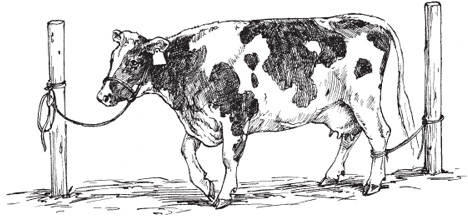
Cow tying prevents a cow from kicking her newborn calf when it tries to nurse.
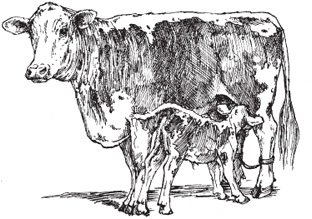
You may have to put hobbles onto the hind legs of a mother cow if she continues to kick her calf.
A small three-sided shed like this one protects calves from the weather while keeping cows out.
Offer the cow feed and clean, lukewarm water to drink. She should eat and drink soon after calving. If she won’t eat or drink or seems dull, she may have a problem; consult your vet. Take her temperature to see if she has a fever.
Most cows do fine after calving. Just watch your cow closely to make sure all is well. Give her as much good hay as she wants, but only a small amount of grain at first, until the swelling of her udder disappears. A high-producing cow fed a lot of grain just before or just after calving may have problems.
Milk your cow at least twice a day, even if the calf is still with her. The calf cannot drink all of her milk. Milking the cow will help reduce the pressure and swelling in her udder and will relieve a quarter (one of the four teats) the calf may have missed.
Natural Nursing
A commercial dairy takes calves away from their mothers for several reasons: so they can utilize the cows’ milk; it can be cheaper to raise calves on milk replacer than on milk; it simplifies management; and a high-producing dairy cow’s udder is large and delicate and may be easily injured and subsequently infected (develop mastitis) by a calf that bunts at the udder while nursing. A family milk cow, however, generally doesn’t have the massive udder of a big-time dairy cow, and many owners of a family cow let their calves nurse. You can let your cow nurse her calf and still have milk for yourself, in one of two ways:
• Pen the calf away from the cow at night. Milk the cow in the morning, then let the calf back in with the cow to nurse during the day. However, when a calf lives with the cow, the cow may prefer to have the calf nurse rather than let you milk; this tractability issue varies from cow to cow.
• Keep the calf penned separately from the cow and put them together at milking time, letting the calf nurse one side of the udder (two quarters) while you milk your side. By this method, a cow that would rather nurse her calf than be milked will be more cooperative and let down her milk. You just have to make sure you can milk about as fast as the calf nurses, or it may try to rob your side when its side is empty. Take care not to let the calf slobber in your milk bucket.
Dehorning, removing extra teats on a heifer, and castrating a bull should be done while the calf is still young. For these procedures you may want your calf restrained and lying on the ground. To hold the calf still while it’s lying on its side being castrated or having extra teats removed, kneel down and hold the calf’s front leg (folded at the knee). Put gentle pressure on the neck with your knee so the calf cannot rise.
Most heifers have just four teats, but some are born with an extra one or two. An extra teat is of no use to a cow and may cause problems when she is being milked. If your calf has an extra teat, it should be removed.
As soon as the heifer is big enough for you to tell which teat is the extra one (generally at 1 to 3 weeks of age), the teat can be removed. The extra teat is easier to locate when she is lying down. Examine her udder closely. The four regular teats will be arranged symmetrically, with the two rear teats slightly closer together than the two front ones. An extra teat is usually smaller than the others and located close to the main teats. Before removing a teat, make sure it is truly the extra one. You don’t want to make a mistake and remove the wrong teat.
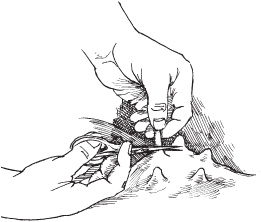
Snip off an extra teat with sharp, disinfected scissors.
Flanking a Calf
To get your calf to the ground easily and gently, without a big struggle, flank it. Stand close to the calf. Reach over its back and grab hold of the flank skin with one hand and the front leg (at its knee) with your other hand. Lift the calf off its feet, gently lowering its body to the ground.
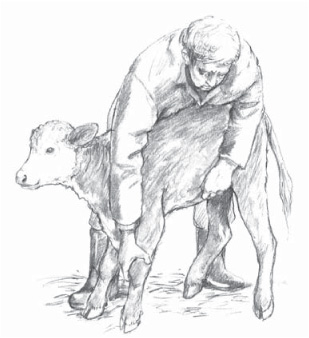
If you are not sure which teat should be taken off, wait until the calf is older and the teat is more developed, then have your veterinarian do the removal. Removal of an extra teat in an older heifer should always be done by a vet because the wound will bleed more and may need stitches.
The small extra teat on a baby heifer is easy to remove. Flank the heifer (see box above) and put her onto the ground. Disinfect the teat to be removed and snip it off with sharp, disinfected scissors. Hold the scissors with the handle directed toward the front of the calf and the blades pointed toward her tail end. Make the cut lengthwise with the body. Afterward, dab the wound with tamed iodine.
Another method is to tie the heifer and remove the teat while she is standing, preferably with someone holding her back end so that she can’t move around. Pull the extra teat down and snip it off cleanly where it meets the udder. Swab with disinfectant.
A young heifer rarely bleeds when an extra teat is removed. In the summertime, use fly repellent to keep flies away from the small wound.
A bull calf should be castrated at an early age, the younger the better. All bull calves should be castrated, unless they will be used for breeding.
Castration is harder on a calf the older he gets. As the testicles grow, the blood vessels supplying them also become larger. Bleeding is always a risk when castration is done surgically, a procedure that should be performed by an experienced person.
Baby calves are easy to castrate by using an elastrator ring, which is a strong rubber ring that resembles a large Cheerio. To put the rubber ring onto a calf, he should be lying down on his side, with someone holding his head and front leg so he can’t wiggle around while another person puts on the ring.
Using an elastrator tool, the ring is stretched and placed over the scrotum at the top of the scrotal sac, above the testicles. The tool is removed, leaving the rubber ring to constrict tightly, cutting off all circulation and feeling below it. The testicle tissue gradually dies, and the scrotal sac shrivels up and drops off a few weeks later, leaving a small raw spot that soon heals. Elastrator rings are the easiest and safest way to castrate baby calves, because they cause no bleeding.
If your calf has horns, they should be removed; cattle with horns may hurt one another or you. Dehorning should be done when the calf is young and the horns are small. Older calves or mature cattle with large horns may bleed a lot when their horns are removed, or they may get infections.
A caustic dehorning paste or stick can be used for a calf that’s a few days old. An electric dehorner is often used on calves up to 3 months of age. The hot dehorning iron is held firmly against the head over the horn for long enough to kill the horn-growing cells at the base of the horn. Unless you are raising a lot of calves, you may prefer to have an experienced person who owns the appropriate appliance dehorn your calves for you.
Maintaining proper housing and sanitary conditions, providing an adequate diet, and adhering to a vaccination program go a long way toward keeping your cattle healthy. The following measures will help you avoid having your calves or cow suffer needlessly, as well as avoid incurring the expense of treating an illness.
Vaccinations. For some illnesses, no vaccines are available. Most diseases, however, can be prevented with good care, prevention of exposure to infectious agents, and vaccination. Cattle need vaccinations against such diseases as blackleg, malignant edema, and brucellosis. Talk with your veterinarian about a vaccination program to protect your cattle from the diseases common in your area. A single family cow, or a calf or two raised for beef, may not be exposed to some diseases that are more likely to affect cattle in larger groups.
Keep cattle comfortable. To prevent illness and avoid stress, feed your cattle properly and make sure they have shelter from the elements in both cold and hot weather. A heat wave in summer may kill cattle if temperature and humidity get too high. During hot weather, use a fan in the stall, or hose down your animal periodically with a misty wet spray from a garden hose.
Sanitation. Good sanitation is important. It is easier to prevent infectious diseases than to cure them. If several animals share a pen or a barn, or if others have been there before, bacteria, parasites, and viruses are lurking. To help prevent disease and infections, thoroughly clean and disinfect your facilities before installing a new calf. Get rid of all old bedding and scrub the walls and floor with a good disinfectant; your veterinarian or dairyman can recommend one.
Keep pens clean and well bedded. A cow must not lie on dirty bedding or in mud and manure. Mastitis and blind quarters can result from bacteria entering the teat when a cow lies in dirty places. A blind quarter is a quarter of the udder that does not produce milk because it has been damaged by infection. If your cow gets an udder infection, consult your vet. Do not let this infection go untreated, or it may ruin your cow for milking.
Pay close attention to your cattle every day so you can tell whether they are feeling fine or getting sick. If you feed your animals twice a day, you can check for signs of illness at each feeding. Even cattle that receive good care may become sick. If you notice illness early and start treatment promptly, you should be able to catch most problems in time to help the animal recover quickly. Get to know your cattle so you can recognize the following signs.
Watch for Loners
If you have several cattle, one that is off by itself should be checked on. A sick animal often wants to be alone.
A healthy animal is bright and alert and has a good appetite. It comes eagerly to its feed or grazes at regular times each day. A sick animal may spend a lot of time lying down. It may seem dull, and its ears may droop instead of standing up alert. It may stop chewing its cud because of pain, fever, or a digestive problem.
A healthy animal usually stretches when it first gets up and shows an interest in its surroundings. It responds with curiosity to sounds and movement and spends some time grooming itself. It walks with a free and easy gait. In contrast, a sick animal may show less interest in things around it. It may stand up slowly or with effort. All of its movements will be slow, and it lacks the spark of vitality and health shown by a normal animal. The more serious the illness, the more indifferent the animal will be to its surroundings, and the more reluctant to move.
A sick animal with a fever breathes fast. However, exercise or hot weather also make a healthy animal breathe faster. Cattle don’t have many sweat glands. They cool themselves by panting.
Check each animal’s respiration rate when it is standing quietly or lying down. Its respiration rate should be about 20 breaths per minute (10 to 30 is normal). An easy way to figure the respiration rate is to watch the animal’s sides move in and out. Each in-and-out movement counts as one breath. Using the second hand on your watch, count the breaths for 15 seconds, then multiply by 4 to get the number of breaths per minute.
The normal body temperature for a cow or calf is 101.5°F (38.6°C). A temperature of more than 102.5°F (39.2°C) signals a fever. Learn how to take your animal’s temperature by using a rectal animal thermometer, which you can buy from your veterinarian. Tie a string to the ring end to avoid losing it in the animal’s rectum.
To take your calf’s temperature, restrain the animal in a chute. Digital thermometers are inexpensive, available at any drugstore, easy to read, and big enough to find quickly if you drop one. If using a mercury-in-glass thermometer, shake it until it reads less than 98°F (36.6°C). Moisten the thermometer with petroleum jelly so it will slide in easily. Gently lift the calf’s tail and insert the thermometer into the rectum. Keep hold of the string, because the animal may poop out the thermometer, along with a bunch of manure. Leave the thermometer in for two minutes to get an accurate reading. When you take out the thermometer, wipe it with a tissue or paper towel so that you can read it. Disinfect the thermometer after each use.
A fever indicates that the cow or calf is fighting a bacterial or viral infection. If her temperature is 103.5°F (39.7°C) or above, call your veterinarian. Belownormal temperatures can also be a sign of something wrong; if she acts sick and has a low temperature, call your veterinarian.
On hot, humid days, a cow or calf’s temperature can easily reach 103°F (39.4°C), even in the shade. If she’s in the sun and panting, move her to a shady spot immediately. To cool her, keep pouring cool water down her back, from head to tail.
Normal Vital Signs
• Normal respiration is 10 to 30 breaths per minute, with an average of about 20.
• Normal body temperature is 101.5°F (38.6°C).
Another indication of the health of an animal is whether its eating habits are normal. Does it chew and swallow properly, or does swallowing seem painful? Is it drooling, dribbling food from its mouth, or having trouble with belching and chewing its cud?
The animal’s bowel movements and urination can also indicate illness. With some digestive problems, the animal becomes constipated. If it has a gut blockage, the manure may become firm and dry, or it may not be able to excrete at all. Other problems in a sick animal may cause diarrhea. Manure should be moderately firm (not runny and watery) and brown or green.
If a bottle-fed or nursing calf has blood in its manure, call your vet. This is often the sign of a serious disease. Early treatment is important.
Urination may become difficult if the urinary tract is blocked, as when a steer develops a bladder stone. The steer may dribble only small amounts of urine, remain in the urinating position for a long time, kick at his belly in pain, or stand stretched. If he shows any of these signs, call your veterinarian.
Pay attention to abnormal posture. Resting a leg may mean lameness. Arching the back with all four legs bunched together is usually a sign of pain. A bloated animal may stand with its front legs uphill to make belching gas easier. A sick animal may lie with its head tucked around toward its flank.
If your animal becomes sick, recognizing the symptoms early and knowing what to do can make all the difference. A disease can have an infectious or noninfectious cause. Noninfectious diseases include bloat, poisoning, founder, and injury. Infectious diseases are those caused by microorganisms or parasites. The most common microorganisms are bacteria, viruses, and fungi. Infectious diseases can be contagious, such as pinkeye, or noncontagious, such as infection of a wound or abscess
A large increase in an animal’s grain ration can cause overproduction of lactic acid in the rumen, resulting in acidosis—too much acid in the animal’s body.
Symptoms/effects: If acidosis is not promptly treated, the rumen will stop working. The animal may get fever, diarrhea, or founder (see page 317), and it may die.
Prevention: Acidosis occurs most often when the grain ration is increased too rapidly. It can also happen if something interferes with the regular feeding schedule, causing an animal to overeat. For example, if a calf’s water has manure in it, the calf won’t drink it; then, because it’s thirsty, the calf may quit eating. After the calf’s water tub is cleaned and it drinks again, the calf may load up on feed.
To prevent acidosis, stick to your feeding schedule. Split the daily grain ration and feed twice a day, so that an animal doesn’t eat a large amount of grain at once. When increasing the grain ration, do it gradually, over a couple of weeks.
Treatment: Fast action may be needed to save your cow or calf or to prevent founder. Call your vet immediately if your animal shows symptoms of acidosis.
Blackleg is one of several serious diseases caused by clostridia, a group of bacteria that live in the soil. This family of diseases includes tetanus, red water, malignant edema, and enterotoxemia.
Symptoms/effects: Cattle become sick suddenly and usually die.
Prevention: A good vaccine that prevents blackleg is available. Your calf should be vaccinated at about 2 months of age and receive a second dose of vaccine around weaning time.
Vaccines are available that protect against several of the other clostridial diseases. Check with your vet to see which vaccine you should use for your calf.
Some clostridial diseases are a problem only in calves. Once calves are vaccinated, they have lifelong immunity. Others, such as red water, can be deadly at any age. If red water is a problem in your area (as it is in the Northwest), all cattle must be vaccinated every six months.
Bloat is a digestive problem that is often caused by highly fermentable feeds. Harmful bacteria that create gas when they multiply can also cause bloat. If too much gas builds up in the rumen, burping may not get rid of it, especially if the gas is frothy. The tight rumen eventually puts so much pressure on the lungs the animal can’t breathe, and pressure on large internal blood vessels interferes with blood circulation.
Symptoms/effects: When viewed from behind, an animal with bloat looks puffed up on its left side, where the rumen is located. As bloat gets worse, both sides puff up, and the animal has trouble breathing.
Prevention: Avoid giving feeds that promote bloat, such as lush alfalfa pasture, rich alfalfa hay, too much grain, or finely chopped hay or grain.
Treatment: Severe bloat must be relieved quickly. Your vet may pass a tube into the animal’s stomach to release the gas. If the bloat is frothy, it won’t come out easily, and the vet will pour mineral oil through the tube to break up the foam.
Cattle that bloat often can be fed Bloat Guard, which contains an antifoaming agent. It comes in block form. Give Bloat Guard in place of a salt block, and let your cattle use it for several days before you start them on fermentable feed.
To treat a small calf for bloat, you can use an esophageal feeder to administer Therabloat Drench Concentrate mixed with water.
Brucellosis is also called Bang’s disease. Although it is not common in North American cattle, it is still taken seriously since it can be transmitted to people—causing fever and headache—through contact with an infected animal or infected meat or milk.
Symptoms/effects: Brucellosis causes abortion in cows.
Prevention: In areas where brucellosis may be a risk, all heifers must be vaccinated between 2 and 10 months of age. A cow that has been vaccinated will have a small metal tag in her ear with a number on it; the same number will be tattooed in her ear. If you live in an area that requires vaccination, never buy a cow that has not been vaccinated. A cow cannot be vaccinated past calfhood, because if tested for brucellosis she may be a reactor (test positively).
The requirement to vaccinate heifers has nearly eradicated this disease in cattle in the United States. In some states, especially those in the greater Yellowstone area, heifers must still be vaccinated because the disease is spread by infected wildlife, such as elk and bison. Since the disease occasionally appears in other areas, vaccination requirements change from time to time. Your county Extension agent can tell you if cows in your area are required to be vaccinated. Steers do not need this immunization.
Coccidiosis is a disease of calves caused by protozoa—tiny one-celled animals that damage the intestinal lining. The protozoa are transmitted in the manure of sick calves and carrier animals. Carriers are not sick but have some protozoans living in their intestines. A calf may pick up the coccidia by eating contaminated feed or water or licking itself after lying on dirty ground or bedding.
Symptoms/effects: Coccidiosis causes severe diarrhea. The loose, watery manure often contains blood.
Treatment: Have a veterinarian examine a calf that starts passing really loose manure, and especially if it has blood in it or the calf strains after passing the loose bowel movements. The vet can recommend an appropriate treatment.
Prevention: Deccox medicated crumbles mixed with feed, or Deccox medicated powder mixed with milk, can help prevent coccidiosis. You can also have the feed mill add Deccox to your calf grain, or you can use milk replacer that already contains Deccox.
Be Careful with Medications
When using any medications or vaccines, always read the labels and follow the directions for dosage, administration, and other factors. If you don’t understand the directions, ask your vet for clarification. Store medicines properly. Some need to be refrigerated, whereas others shouldn’t be. Some need to be kept out of the sunshine. Some need to be shaken well before use.
An infection of the throat and mouth, diphtheria is caused by the same bacteria that cause foot rot. Injury to tissues of the mouth or throat can let the bacteria gain entrance. Cattle are most susceptible through 2 years of age. Emerging teeth or injuries caused by coarse feed or sharp seeds can open the way for infection.
Symptoms/effects: Calves with diphtheria have fever. They may act dull and uninterested in eating. The calf may have a cough and will drool because it has a hard time swallowing. It may have swelling of the cheek tissues, and its breath may smell bad. Swelling at the back of the throat can block the windpipe and make breathing difficult. The calf may die of infection or of obstruction of the air passages unless treated quickly.
Treatment: Diphtheria can be serious. If the symptoms are present, call your vet immediately. Proper antibiotic therapy is important.
Flies bite and suck blood and annoy and irritate cattle.
Symptoms/effects: Cattle trying to escape flies may spend all their time in the shade. They therefore may not graze or eat as much as they should.
Treatment: Horn flies and face flies can often be controlled by using insecticide ear tags. While in the animal’s ear, the tag continuously releases insecticide as it rubs against the hair. The animal rubs the insecticide over its body as it reaches around and scratches itself. For a milking cow, use only insecticides approved for dairies.
Foot rot is caused by bacteria that live in the soil. Cattle may get the infection if they have a break in the skin on a foot and walk through wet, muddy areas.
Symptoms/effects: Foot rot causes swelling, heat, and pain in the foot, resulting in severe lameness. The swelling and lameness come on suddenly; the animal may be fine one day and lame the next. The foot may be too sore to walk on.
Treatment: Foot rot heals quickly if it is treated early with appropriate antibiotics. Consult your veterinarian.
An animal can develop founder if fed too much grain or its ration is changed suddenly.
Symptoms/effects: The attachments between the hoof wall and the sole of the foot become sore and may separate, resulting in malformed hooves and severe lameness. Acidosis (see page 316) is the main cause of founder.
Treatment: Founder is a serious emergency. Contact your vet immediately.
Cattle grubs, also called warbles, sometimes appear under the skin on the backs of cattle in late winter or early spring. The grub is the maggot stage of the heel fly. This fly lays its eggs on the lower part of the legs of cattle during the warm days of early summer. The grub travels through the body to the animal’s back.
Symptoms/effects: Grubs look and feel like marbles under the hide. An animal bothered by heel flies may run wildly with its tail in the air and may even crash into fences. It will look for shade and try to stand in a water hole to escape the flies.
Treatment: If grubs and heel flies are a problem in your area, consult your vet about the best way to get rid of them. Pour-on products are available that treat lice and grubs at the same time.
Hardware disease is also called traumatic reticulopericarditis. Cattle are indiscriminate eaters and will swallow bits of wire and other objects as they eat. Sharp objects that penetrate the reticulum can cause peritonitis, which may be life threatening, or extend into the heart cavity, killing the cow.
Symptoms/effects: An affected cow goes off feed, shows signs of pain, may have a fever, and may have difficulty breathing.
Prevention: Maintain a safe environment free from wires and other metallic objects. A cow kept in a barn or small enclosure can be given a cow magnet by mouth to try to bind metal objects and keep them in the reticulum.
If your pasture fence is old and broken but you can’t replace it just yet, use a metal detector along the fence line to pick up stray staples or pieces of barbed or woven wire that a cow could accidentally ingest.
Treatment: Antibiotics can be used but in a severe case will not be effective. Surgery may be considered for a valuable animal.
Internal worms commonly infest cattle, especially young animals that have not developed resistance to them. These parasites are most often a problem in cattle on pasture.
Symptoms/effects: A calf with worms won’t gain weight fast and may lose weight. It may have a rough hair coat, a poor appetite, diarrhea, or a cough. To tell whether your cattle have worms, have your vet examine a sample of manure.
Prevention and treatment: Medication is available to eradicate worms. However, cattle raised in a clean place will probably not get internal parasites. A calf housed alone in a small pen or hutch that was clean before the calf went in won’t have to be dewormed. Worms become a problem once a calf goes out on pasture with other calves or where other cattle have been.
Johne’s disease is also called paratuberculosis. It is caused by a bacterium, Mycobacterium johne, also known as Mycobacterium paratuberculosis. Johne’s is a reportable disease: When it is found in an animal, others in the herd must be tested by skin injection or blood or fecal culture. Affected herds are usually quarantined and regularly examined by state regulatory authorities until they are deemed healthy. These measures have drastically reduced the incidence of Johne’s disease in cattle.
Store Medical Supplies Safely
Make sure all livestock medications and treatments (such as iodine, insecticides, and antibiotics) and needles and syringes are kept in a safe place, out of the reach of children.
Symptoms/effects: Johne’s disease causes chronic diarrhea and wasting (severe loss of condition) in adult cattle.
Prevention: Johne’s disease has no known treatment and no vaccine. Affected animals must be destroyed. The best way to avoid this disease is to purchase animals from a herd that is free of Johne’s disease.
This bacterial disease is spread by mice, rats, and other rodents; wildlife; and infected domestic animals, such as pigs, dogs, and other cattle. Cattle can get lepto from contaminated feed or water.
Symptoms/effects: Leptospirosis is a mild disease in cattle, but it can have serious side effects, such as abortions in pregnant cows.
Prevention: Heifers and cows should be vaccinated against leptospirosis at least once a year. Some veterinarians recommend vaccination every six months.
Lice multiply swiftly in cool or cold weather and can build up in large numbers on cattle.
Symptoms/effects: Calves that are itchy, rubbing out the hair over the neck and shoulders, may have lice.
Treatment: Delouse all cattle in late fall and again in late winter. Talk with your veterinarian about a good lice control program. Your veterinarian, county Extension agent, or local farm supply store can recommend a product for getting rid of lice. When treating a dairy cow, use only products approved for dairies. Wear protective clothing, goggles, and rubber gloves when you apply the product. Read the label thoroughly before use. If it is a powder, do not breathe the dust. Apply it on a calm day with no breeze. Easier to use than a powder is a pour-on product that needs to be applied only along the animal’s back. The treatment will kill the lice but not the louse eggs. It must be repeated at least once to kill lice that have not yet hatched.
For the more organically minded, dusting your cattle with diatomaceous earth will help control lice.
Lumpy jaw can occur after a calf eats hay or grass with sharp seeds in it. Foxtail or downy brome (cheat grass) seed pods have sharp stickers that can get caught in the mouth and poke into the cheek tissue. A sticker that pokes in deeply may open the way for bacteria to cause infection, and the wound may become an abscess.
Symptoms/effects: An abscess in a calf’s mouth may get as large as a tennis ball, causing the cheek to bulge prominently.
Treatment: The abscess must be punctured and drained. Abscesses sometimes break and drain on their own, but they heal faster and with less scar tissue if they are lanced and drained. A veterinarian or other experienced person should treat an abscess. Severe cases may require antibiotic therapy.
In some cases, the abdominal wall at the navel area does not close up properly after the birth of the calf, causing a bulge at the navel.
Symptoms/effects: In a hernia, soft tissue passes back and forth through the hole in the abdominal wall. If the swelling at the navel is firm, an abscess is the cause.
A small hernia may go away as the calf grows. However, a large hernia is serious, because a loop of intestine may come through it and strangulate, causing a portion of it to die and kill the calf. A bacterial abscess can spread through the body, causing severe illness and serious joint infections.
Treatment: If your calf has a swelling at the navel, have a veterinarian look at it. An abscess can be treated by lancing, draining, and flushing with antibiotics. If a hernia is present, the vet can tell you whether it will get better on its own or whether stitches are needed to close up the hole.
Pinkeye usually appears in summer, because the bacteria that cause it are spread by face flies. Pinkeye often occurs when flies, dust, sunlight, or tall grass irritates eyes. Flies carry the bacteria from one animal to another. Pinkeye is contagious, and it may not be a problem if an animal lives alone, unless other cattle are within the distance face flies travel, which can be several miles.
Symptoms/effects: An animal with pinkeye will hold the eye shut, because it is sensitive to light. The eye will water. After a day or two, a white spot will appear on the cornea at the front of the eyeball. As the disease worsens, the spot grows larger and the cornea becomes cloudy and blue.
Treatment: A mild case of pinkeye may clear up without treatment, but a serious case can cause blindness. Pinkeye should be treated promptly with an antibiotic powder or spray, which your vet can recommend. Restrain the animal so you can squirt the medication right into its eye. Because the calf’s tears will wash medications out of the eye, administer the treatment at least twice a day.
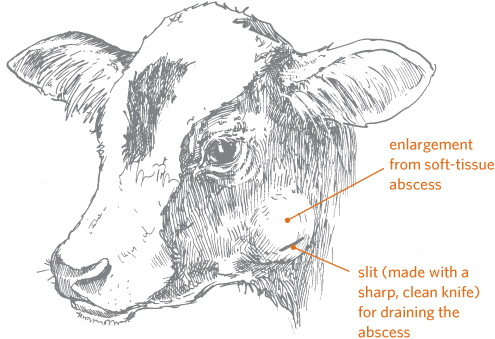
A cheek abscess may need to be lanced to return the cow to good health.
Early detection and diligent treatment should clear up pinkeye within a few days. If you can, bring the cow or calf inside, out of the bright sunlight, to make her more comfortable. A longacting injection of the antibiotic oxytetracycline can also help clear up the infection.
Pneumonia is the second most common killer of young calves. If you spot the warning signs early and start treatment quickly, pneumonia will be a lot easier to clear up.
Symptoms/effects: Pneumonia can be mild or swift and deadly. An animal coming down with pneumonia usually stops eating and lies around or stands humped up, looking depressed and dull. Its ears may droop. Respiration may be fast or labored and grunting. The calf may cough or may have a snotty or runny nose.
Causes: Pneumonia can be caused by viruses or bacteria. The germs that cause pneumonia are relatively plentiful in the environment. They make a calf sick only if its immunity is poor or its resistance is lowered by stress. Cattle of all ages can develop pneumonia, but young calves 2 weeks to 2 months of age are especially susceptible.
A newborn calf that doesn’t nurse soon enough or get enough colostrum (see page 310) will not receive the antibodies needed for adequate immunity. A young calf that has been weakened by a bad case of scours may come down with pneumonia. Severe stress can also make cattle of any age susceptible to pneumonia. Stressful conditions include overcrowding, wet and cold weather, sudden changes in weather from one extreme to another, a long truck haul, or bad weather during weaning. Poor ventilation in sheds and barns can also lead to pneumonia.
Treatment: Confine the animal and take its temperature. If it’s greater than 102.5°F (39.2°C), call your veterinarian. A temperature greater than 104°F (40°C) is serious. Antibiotics should be given immediately, even if the illness is caused by a virus. Antibiotics will fight secondary bacterial invaders, which are the killers. Your vet may leave medication with you, along with instructions for treatment. A sick calf will need good basic care, which includes shelter to keep it warm and dry, and sufficient fluids, especially if it isn’t eating or nursing enough. Fever can cause dehydration.
For a serious case of pneumonia, try to reduce the pain and fever so the animal will feel better and start eating again. Dissolve two aspirin tablets in a little warm water and use a syringe to squirt the mixture into the back of the calf’s mouth. For a larger animal, other medications can be used; consult your veterinarian.
Don’t stop treatment too soon. You may think you can stop giving medication because the animal seems to be getting better and its fever is down. But if the symptoms return, the animal will be twice as hard to treat. Give antibiotics for at least two full days after symptoms have disappeared and the body temperature is normal again. A case of pneumonia usually requires at least one full week of care.
Vaccinate your cattle against the most common viral diseases, such as infectious bovine rhinotracheitis, bovine virus diarrhea, and parainfluenza type 3. These diseases often progress to pneumonia because the virus weakens the animal and allows bacteria to move into the lungs. Discuss a vaccination schedule with your veterinarian.
This fungal infection occurs most commonly in winter. It is spread from calf to calf directly or by calves rubbing against the same posts.
Don’t Mix Medications with Milk
Do not mix electrolytes with milk, especially if your electrolyte mix contains sodium bicarbonate. Mixing medications with milk or milk replacer can prevent curd formation and can worsen diarrhea. Wait two or three hours after milk feeding before giving the fluid with electrolytes. Space the fluid treatments between the regular feedings.
Symptoms/effects: Ringworm causes hair to fall out in 1- to 2-inch- (2.5 to 5 cm) wide circles. The exposed skin is crusty or scaly.
Treatment: Ringworm generally clears up on its own in spring and may not need to be treated. Ringworm is contagious to other cattle and to people; use gloves or wash thoroughly after handling affected animals.
Scours, or diarrhea, is the most common disease of young calves and causes the most deaths. Scours may not be a problem in a big weaned beef calf, but it could be life threatening to a young dairy calf. Viral scours tends to affect calves during the first 2 weeks of life, whereas bacterial and parasitic scours can strike from birth up to about 3 months or even up to 1 year. The youngest calves are usually most susceptible and most adversely affected.
Symptoms/effects: The manure is runny and watery. Severe infections, such as those caused by salmonella bacteria, may cause rapid death, sometimes even before scouring is seen.
Prevention: The key to preventing scours is good management—a healthy cow, an uncontaminated area for calving, clean bedding for the cow, and adequate colostrum for the calf soon after it is born. Vaccinating cows before calving can prevent some but not all types of scours. Following are further preventive measures:
• Protection from weather. A newborn calf needs protection from bad weather.
• Keep it clean. Wash the teats of any cow you have to assist in calving, clean all your equipment between calves (especially bottles and nipples, and your esophageal feeder tube), and move the calf to a clean pasture as soon as it is up and about.
• Isolate a sick calf. Never put a sick calf into the same barn stall or pen in which a cow will calve. Shelter a sick calf in a different shed, and keep a pregnant and calving cow separate from a cow that has already calved.
• Provide timely colostrum. Make sure every calf gets colostrum as soon as possible after birth, no more than two hours later. Don’t thaw frozen colostrum in a microwave or get it too hot; excessive heat destroys the antibodies. Put the container in hot water to let it thaw. It should feel comfortably warm but not hot on your skin before you feed it to a calf.
Causes: Calf scours is a complex problem. Diarrhea can be caused by many things, including bacteria, viruses, and protozoan parasites. Often more than one agent is involved. Overfeeding a calf or using a poor-quality milk replacer can also lead to scours. Poor nutrition and a dirty, wet environment can make calves more susceptible to infections that cause scours. Get help from your veterinarian to determine the cause of diarrhea and how to treat it.
Homemade Electrolyte Mix
To make one dose of electrolyte mix for a scouring calf, mix ½ teaspoon (2.5 mL) of regular table salt (sodium chloride) and ¼ teaspoon (1.25 mL) of Lite salt (sodium chloride and potassium chloride) into 1 quart (1 L) of warm water for a small calf or 2 quarts (2 L) for a large one.
If your calf is critically ill, add ½ teaspoon (2.5 mL) of baking soda (sodium bicarbonate). If the calf is weak, add 1 tablespoon (15 mL) of powdered sugar to the mix. Add a liquid antibiotic, such as neomycin sulfate solution (sometimes called Biosul—you can purchase it from your vet). Use the proper amount for the size of the calf by following the directions on the label.
To help soothe the gut and slow down the diarrhea, you can add 2 to 4 ounces (¼ to ½ cup [59 to 118 mL]) of Kaopectate to this fluid mix. Or, instead of Kaopectate, you can use a human adult dose of Pepto-Bismol.
Treatment: Treatment includes giving the animal electrolyte fluids and administering antibiotics in liquid or pill form. (For information on homemade electrolytes, see above).
To treat a calf at the first hint of sickness, watch it closely. Many clues besides a messy hind end can help you spot trouble before a calf becomes critically ill. Often a calf will act a little dull before it shows diarrhea. It may quit nursing or lie down off by itself. Feeding time is a good time to check on a calf and observe it for signs of illness. Also check the mother’s udder. If a cow has a full udder or is only partly nursed out, take a closer look at her calf. The first sign that a calf doesn’t feel well may be that it stops nursing.
If you catch scours early enough, you may be able to halt the infection before the calf needs fluids and electrolytes. Neomycin sulfate solution can be put into a syringe, to squirt into the back of the calf’s mouth. Use 1 mL per 40 pounds, which means about 2 to 3 mL for a young calf.
A calf with diarrhea must be given fluids. In the early stages, while the calf is still strong, you can give electrolyte fluids with a nursing bottle if the calf will drink it. Oral fluids (by mouth or into the stomach) are adequate and effective because the calf’s gut can still absorb them. However, if a sick calf refuses to drink, fluids will have to be administered by stomach tube or esophageal feeder. A dehydrated calf should be given the fluid-electrolyte mix every six to eight hours, or until the calf feels well enough to nurse from a bottle or nipple bucket again.
As disease progresses, more gut lining is destroyed. The calf becomes weaker, unable to absorb fluid from the digestive tract, and more dehydrated. A calf that becomes this ill requires intravenous fluids given by a veterinarian.
For treating bacterial diarrhea, antibiotic pills are not as effective as a liquid antibiotic. Liquid antibiotic can be squirted into the back of the calf’s mouth or added to a fluid-and-electrolyte mix.
If the antibiotic recommended by your vet is available only in pill form, crush the pills or dissolve them and give them in a liquid. Add enough water so the crushed pills can be added to your fluid mix or squirted into the back of the mouth with a syringe. The liquid antibiotic is needed only once a day, but make sure the calf is nursing or getting fluid three or four times a day to avoid dehydration.
If you give antibiotic to a calf for more than three days, it may kill off the good bacteria as well as the bad. You may then have to give the calf a pill or paste containing the proper rumen bacteria (obtained from your vet) after it recovers, to restore proper digestive function.
Milk need not be withheld from a scouring calf. Rather, the calf should be encouraged to nurse at its regular feedings to keep up its fluid and energy levels. If the calf is too sick to nurse or won’t nurse enough, give it regular feedings by an esophageal tube. Administer medicated fluids and electrolytes between feedings.
It is preferable for a calf to nurse instead of taking milk through an esophageal tube. The act of nursing activates a reflex that causes milk to go directly to the abomasum, bypassing the rumen. When milk is given by tubing, this reflex does not occur, and milk enters the rumen, which could cause irritation (rumenitis). Electrolytes and water, however, are not a problem.
Selenium deficiency is also called white muscle disease and nutritional myopathy. All cattle need adequate selenium in their diets. Many areas of the world are selenium deficient. Some areas, on the other hand, have an excess of selenium in the soils, and forages and grains produced in those areas may contain toxic levels of selenium.
Symptoms/effects: A newborn calf that is selenium deficient may be too weak to stand or to nurse. An older calf may die suddenly from heart failure, especially after exercise or handling. Heifers and cows may abort.
Prevention: When needed, provide selenium in trace mineral supplements. Selenium salt blocks are not adequate in severely deficient areas. Give a selenium injection to pregnant animals a few months before calving. Newborn calves may benefit from a selenium injection. Talk with your veterinarian or Extension agent about the need for selenium supplementation in your area.
Observing Withdrawal Periods
Whenever you administer any drug to your cow or calf, determine the drug’s appropriate withdrawal period—the amount of time that must pass while the drug metabolizes from the animal’s system. A withdrawal period has been established for each drug to ensure that any remaining drug residue has been reduced to an acceptable level, at or below which the animal’s milk or meat is considered safe for humans to eat.
Treatment: Weak calves may respond to selenium injection, but often the damage is severe and they still die.
Warts are skin growths caused by a virus. They affect calves and yearlings more than adult cattle, since mature cattle have usually developed some resistance to the virus. Warts are unsightly but clear up on their own after a few months.
Many medications and most vaccines are given to cattle by injection with a syringe and needle. A calf or cow should always be restrained before you give it an injection or oral medication. A cow should be restrained in a chute. A calf can be confined in a chute or tied up and pushed against a fence; if it is merely tied to the fence, the calf may kick you. A tied calf can’t swing its head away or hit you with its head while trying to avoid an oral medicine. Never stand behind or beside a calf unless it is restrained so it cannot move.
Safety Precaution
After giving an injection, discard the syringe and needle if they are disposable. If they are reusable, boil them before the next use.
Injections are given in one of these three ways:
Intramuscularly: deep into a big muscle; most injections are given this way
Subcutaneously: under the skin, between the skin and the muscle; used to slow the absorption of vaccines and some medications
Intravenously: directly into a large vein; used to speed up a medication’s absorption
Intravenous injections can be dangerous to the animal and should be given only by a veterinarian. But you can learn to give intramuscular or subcutaneous injections. Have an experienced person show you how to fill a syringe, measure a proper dose, and give an injection.
If you’re raising cattle for beef, give injections into the neck muscle to avoid damage to the best cuts of meat, which are in the rump and buttocks. Sometimes an injection causes a local reaction and a knot in the muscle, or even a small abscess. It’s better to have this damage occur in the neck muscle, where it can be trimmed out more easily during butchering.
The injection should be given in the thickest muscle of the neck. Make sure the area where you will put the needle is clean, free of mud or manure, or the needle will take bacteria into the muscle with it. Wet skin and hair increase the risk that bacteria will enter the muscle with the needle.
A balling gun is a long-handled tool that lets you give your calf or cow a pill without having your fingers bitten.
Detach the needle from the syringe. Before putting in the needle, press the area firmly for a moment to desensitize the skin so the animal will not jump as much when jabbed. Insert the needle with a forceful thrust so it breaks the skin easily.
A new, sharp needle goes in with minimal effort and causes minimal pain for the calf. If the calf jumps, wait until it settles down again before you attach the syringe and give the injection. If the needle starts to ooze blood, you’ve hit a vein. Take the needle out and try again in a different spot; never give an injection into a vein.
To give a subcutaneous injection, lift a fold of skin on the shoulder or neck, where the skin is loosest, and slip the needle in. Aim it sideways so it goes under the skin you have pulled up but not into the muscle. With a little practice, you’ll find that subcutaneous injections are easy to give.
Oral medications are given by mouth and are absorbed through the lining of the stomach or intestines. They come in one of two forms.
• Pills can be given with a balling gun, which is a long-handled tool that holds a pill as you insert it toward the back of the animal’s mouth. When you press the plunger, the balling gun pushes the pill out of its slot, forcing the animal to swallow it. This handy tool keeps your fingers from being bitten.
• Liquids might be liquid medications, liquid antibiotics, or pills dissolved in water. They are easy to administer using a big syringe without the needle. Special syringes known as dose syringes have a long nozzle end designed for giving liquids by mouth. Fill the syringe with the proper dose, stick the syringe into the corner of the animal’s mouth, and slowly squirt the medication into the back of the mouth. If the dose is large, give the medication a little at a time, allowing the animal to swallow each portion before you squirt in the rest. Keep the animal’s head tipped up so that the medication cannot run back out.
Don’t Get Bitten!
Be careful when examining the inside of an animal’s mouth or giving pills. A calf has no top teeth in front but can still hurt your fingers with the molars if it bites down. Position your fingers in the space between the lower molars and lower incisors (front teeth).